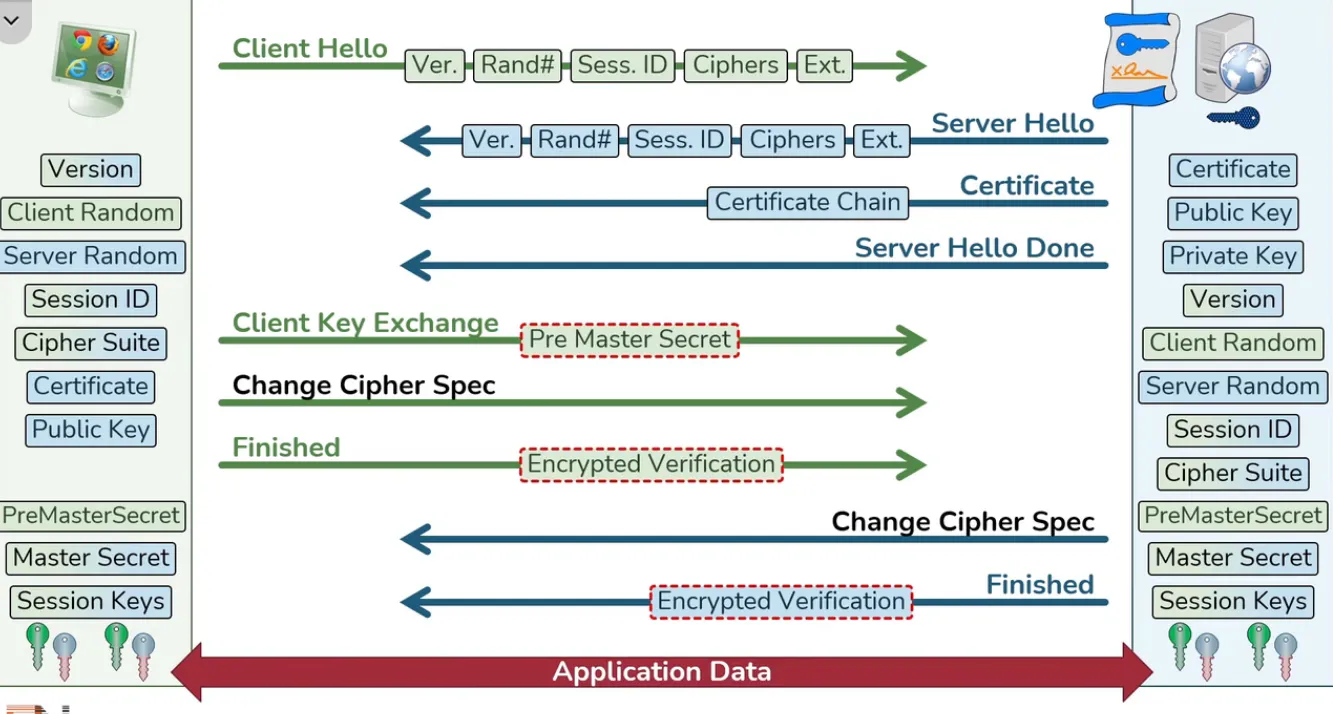TLS Structure and Working
Note > For better appearance, download the image.
Cipher Suites in Handshake
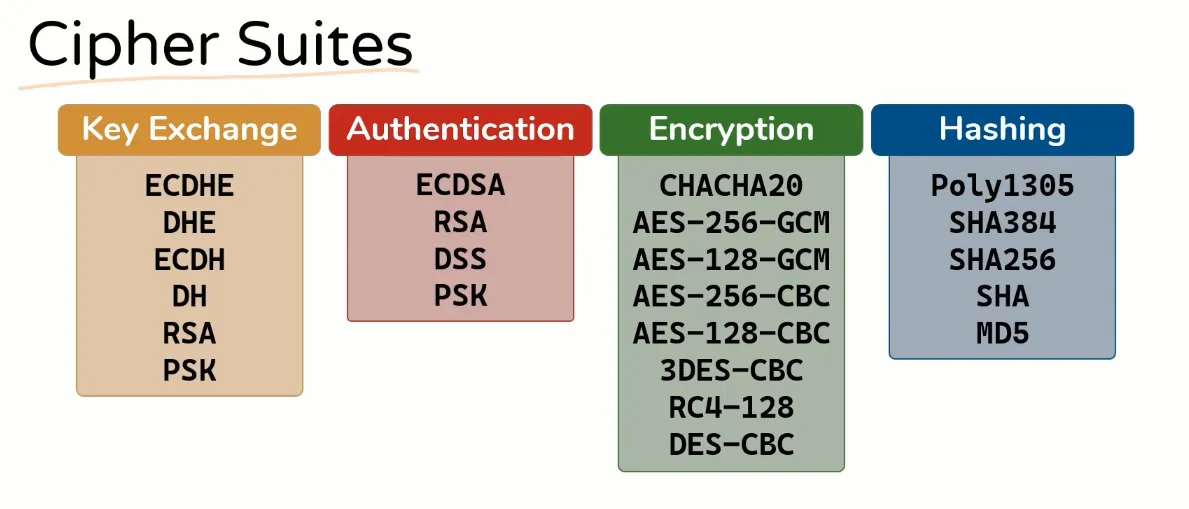
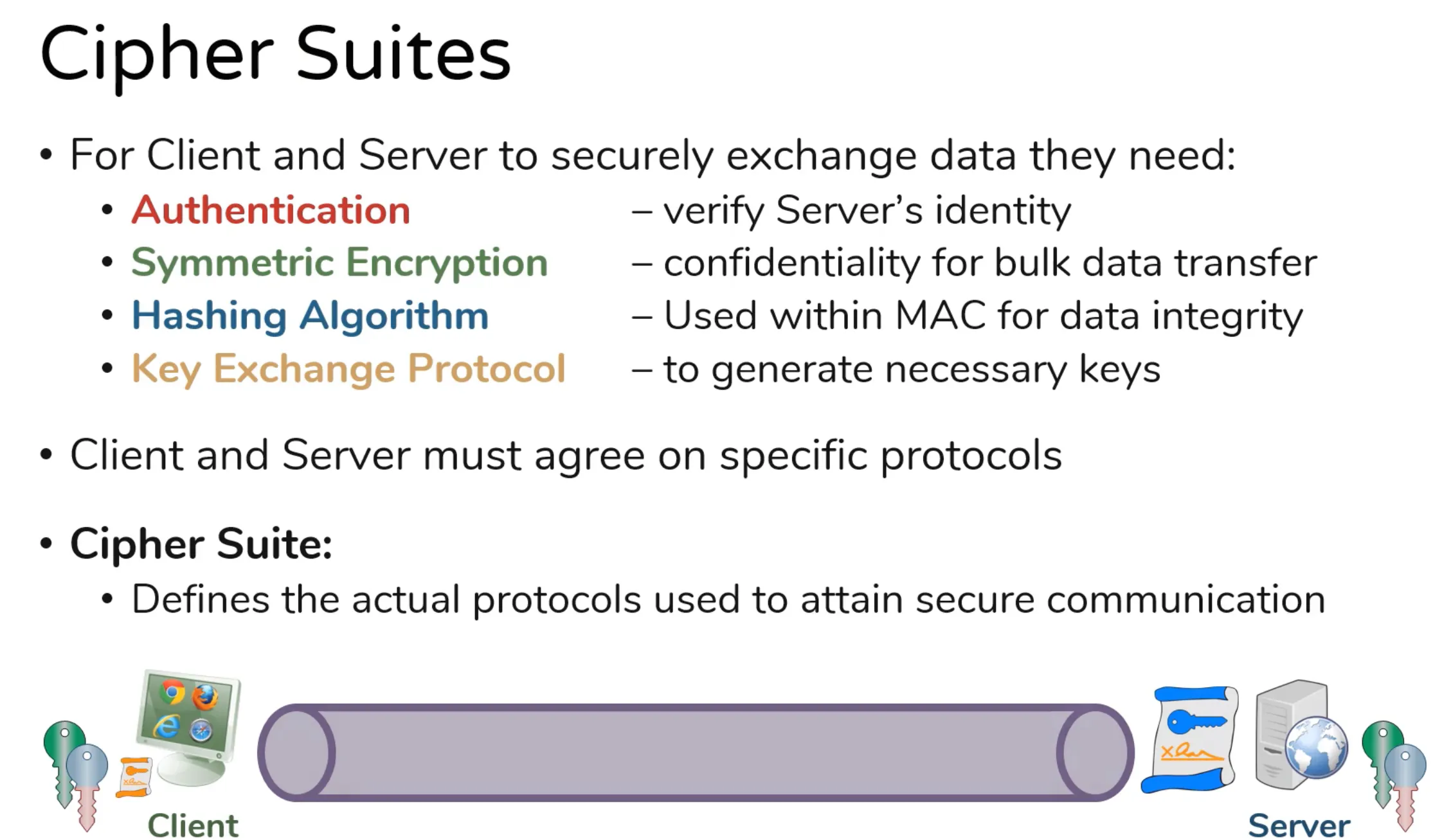
- This Field is present to the TLS Client Hello Packet in Application Layer
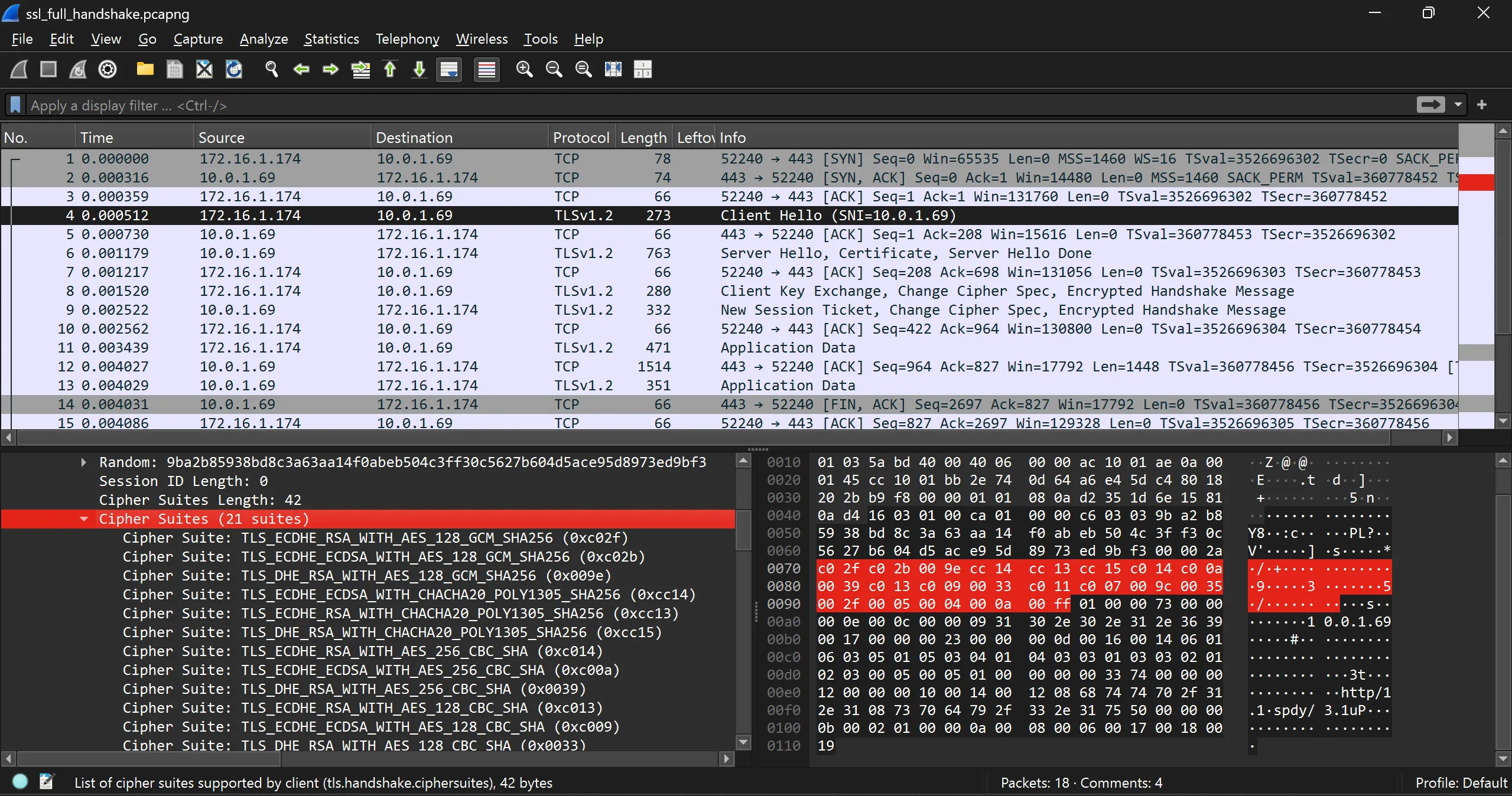

- From Most Secure to Least Secure
- There can be different suites for different version of TLS
Cipher Suites (21 suites)
Cipher Suite: TLS_ECDHE_RSA_WITH_AES_128_GCM_SHA256 (0xc02f)
Cipher Suite: TLS_ECDHE_ECDSA_WITH_AES_128_GCM_SHA256 (0xc02b)
Cipher Suite: TLS_DHE_RSA_WITH_AES_128_GCM_SHA256 (0x009e)
Cipher Suite: TLS_ECDHE_ECDSA_WITH_CHACHA20_POLY1305_SHA256 (0xcc14)
Cipher Suite: TLS_ECDHE_RSA_WITH_CHACHA20_POLY1305_SHA256 (0xcc13)
Cipher Suite: TLS_DHE_RSA_WITH_CHACHA20_POLY1305_SHA256 (0xcc15)
Cipher Suite: TLS_ECDHE_RSA_WITH_AES_256_CBC_SHA (0xc014)
Cipher Suite: TLS_ECDHE_ECDSA_WITH_AES_256_CBC_SHA (0xc00a)
Cipher Suite: TLS_DHE_RSA_WITH_AES_256_CBC_SHA (0x0039)
Cipher Suite: TLS_ECDHE_RSA_WITH_AES_128_CBC_SHA (0xc013)
Cipher Suite: TLS_ECDHE_ECDSA_WITH_AES_128_CBC_SHA (0xc009)
Cipher Suite: TLS_DHE_RSA_WITH_AES_128_CBC_SHA (0x0033)
Cipher Suite: TLS_ECDHE_RSA_WITH_RC4_128_SHA (0xc011)
Cipher Suite: TLS_ECDHE_ECDSA_WITH_RC4_128_SHA (0xc007)
Cipher Suite: TLS_RSA_WITH_AES_128_GCM_SHA256 (0x009c)
Cipher Suite: TLS_RSA_WITH_AES_256_CBC_SHA (0x0035)
Cipher Suite: TLS_RSA_WITH_AES_128_CBC_SHA (0x002f)
Cipher Suite: TLS_RSA_WITH_RC4_128_SHA (0x0005)
Cipher Suite: TLS_RSA_WITH_RC4_128_MD5 (0x0004)
Cipher Suite: TLS_RSA_WITH_3DES_EDE_CBC_SHA (0x000a)
Cipher Suite: TLS_EMPTY_RENEGOTIATION_INFO_SCSV (0x00ff)
- References
- Transport Layer Security (TLS) Parameters : https://www.iana.org/assignments/tls-parameters/tls-parameters.xhtml
- TLS Cipher Suites Pre-build List : >(https://www.iana.org/assignments/tls-parameters/tls-parameters.xhtml#tls-parameters-4)
Key Exchange
- First, We need to generate
seed value (Secret key for HMAC, Secret key for Symmetric Encryption)
Note > From this seed value any number of keys can be generate in future for both parties so key exchange is one time process.
- Here are numbers of algorithms for key exchange,
- PSK
- RSA
- DH
- ECDH
- DHE
- ECDHE
PSK (Pre-Shared Key)
- it
will not provides forward secrecy.
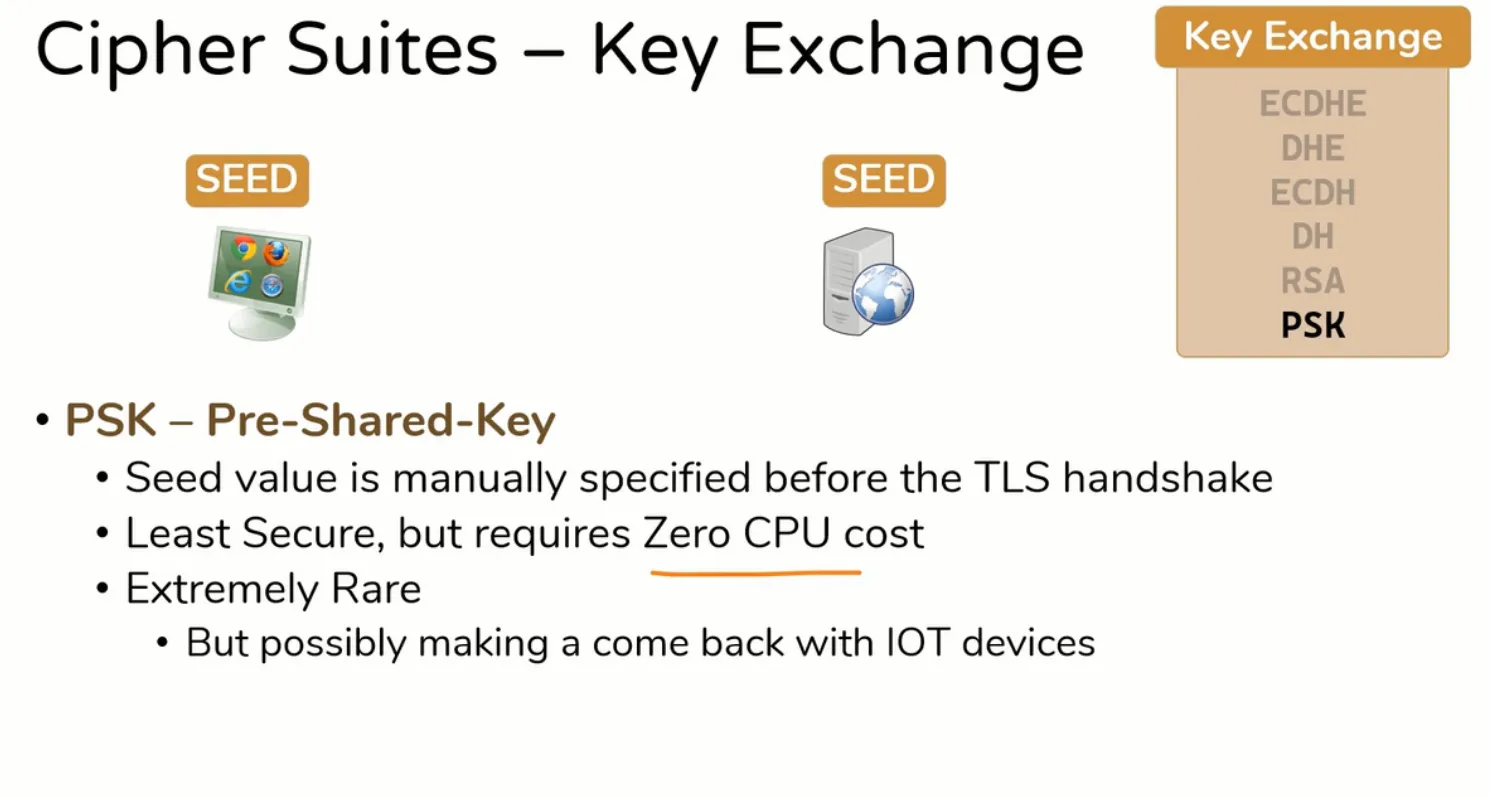
RSA (Rivest-Shamir-Adleman)
- it
will not provides forward secrecy.
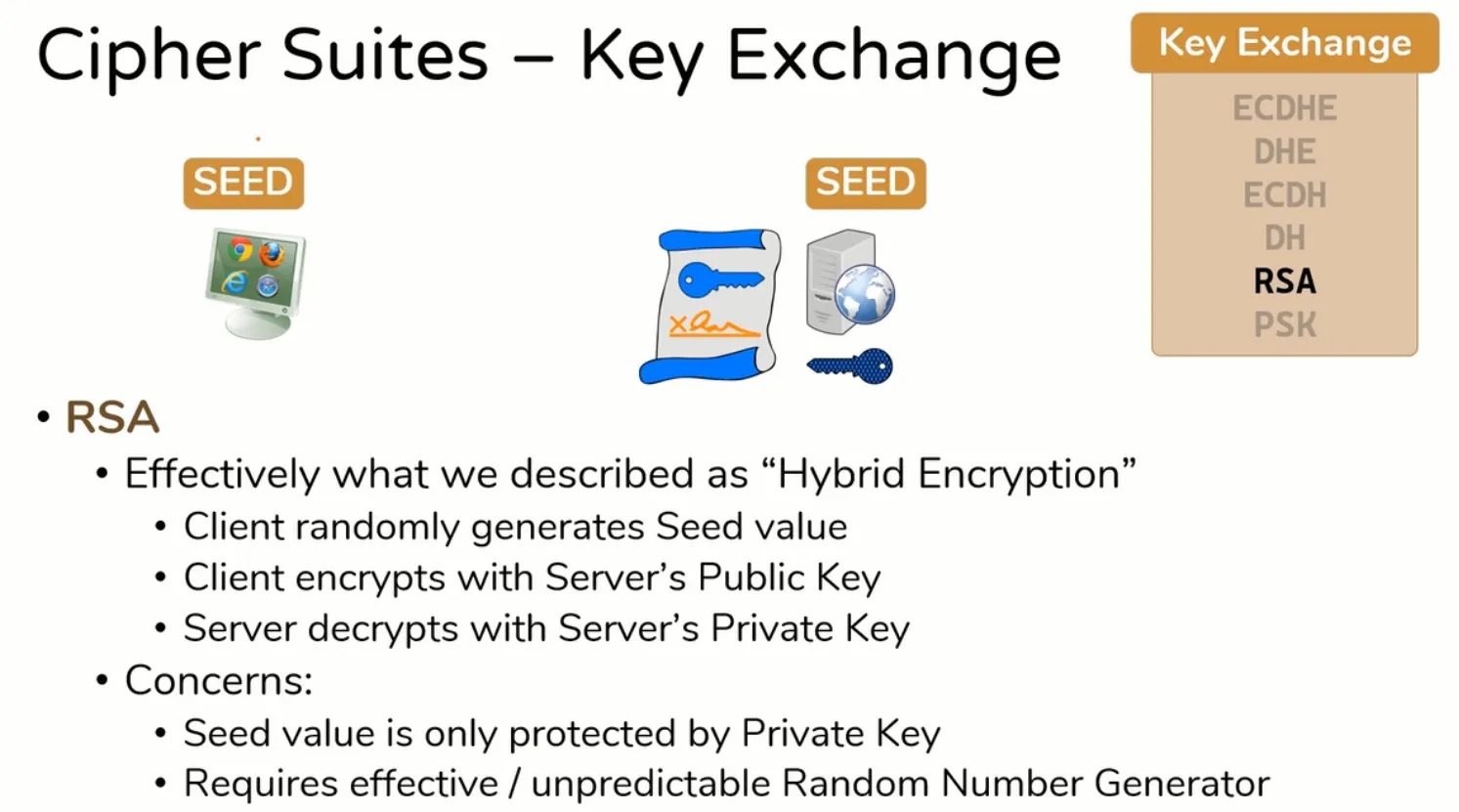
DH (Diffie-Helman)
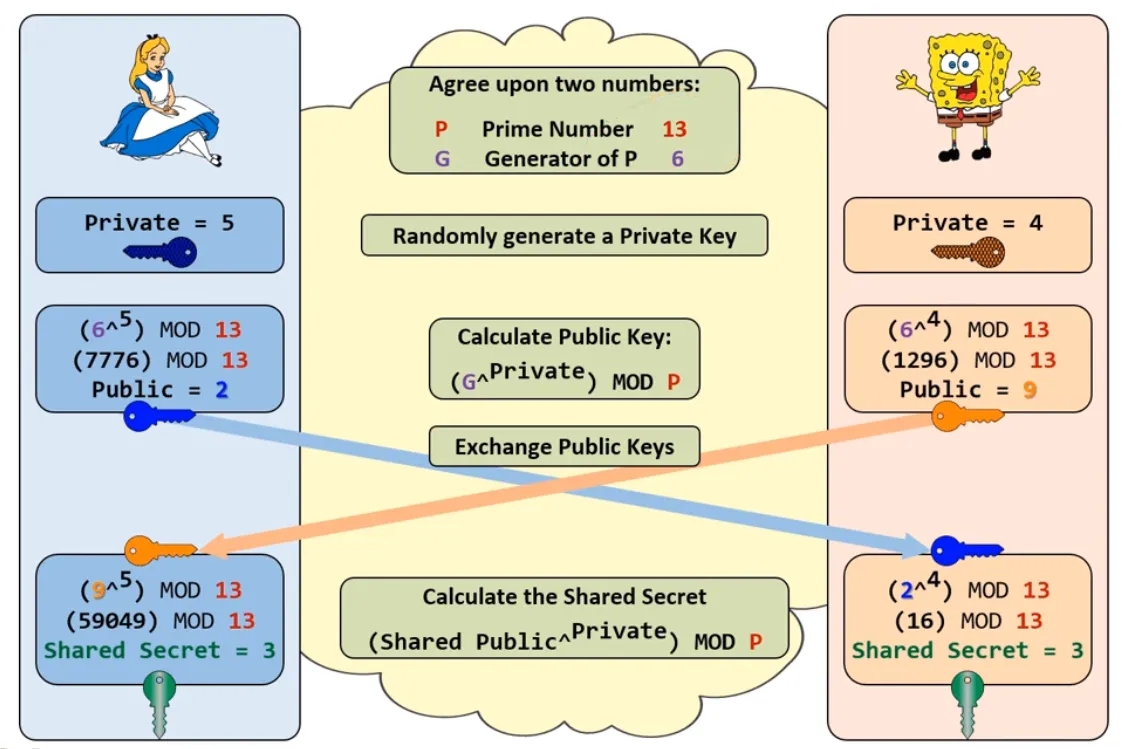
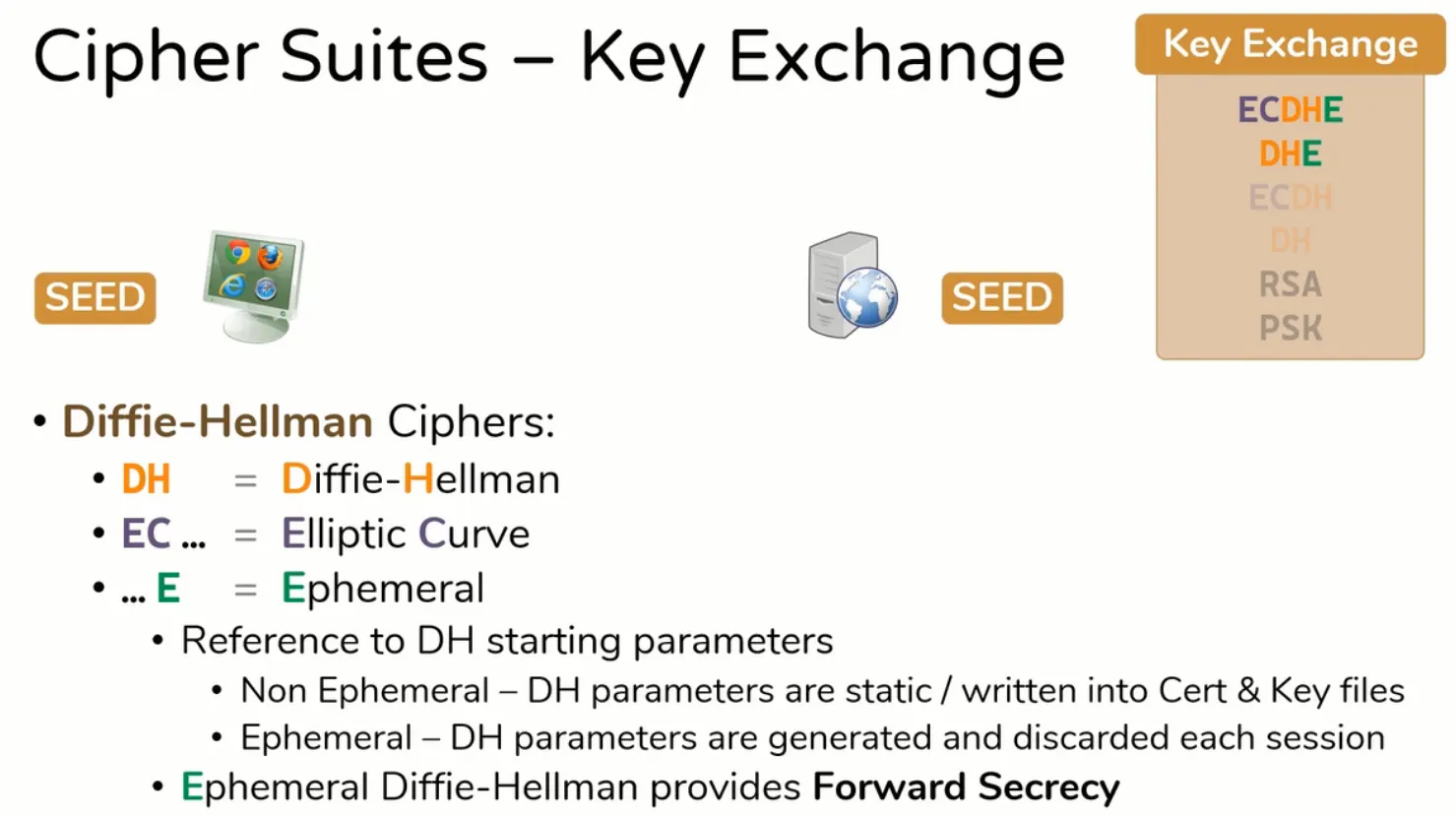
- DH (Diffie-Helman) Variations,
- Elliptic curve Diffie-Helman Ephemeral (DE Parameters are temporary into cert and key file) ECDHE
provides forward secrecy. (More Efficient and Secure then DHE) - DHE Diffie-Helman Ephemeral
provides forward secrecy. - Elliptic curve Diffie-Helman ECDH (DE Parameters are static into cert and key file)
will not provides forward secrecy.(More Efficient and Secure then DH) - Diffie-Helman DH
will not provides forward secrecy. - Parameters such as P, G, Private Key
- Elliptic curve Diffie-Helman Ephemeral (DE Parameters are temporary into cert and key file) ECDHE
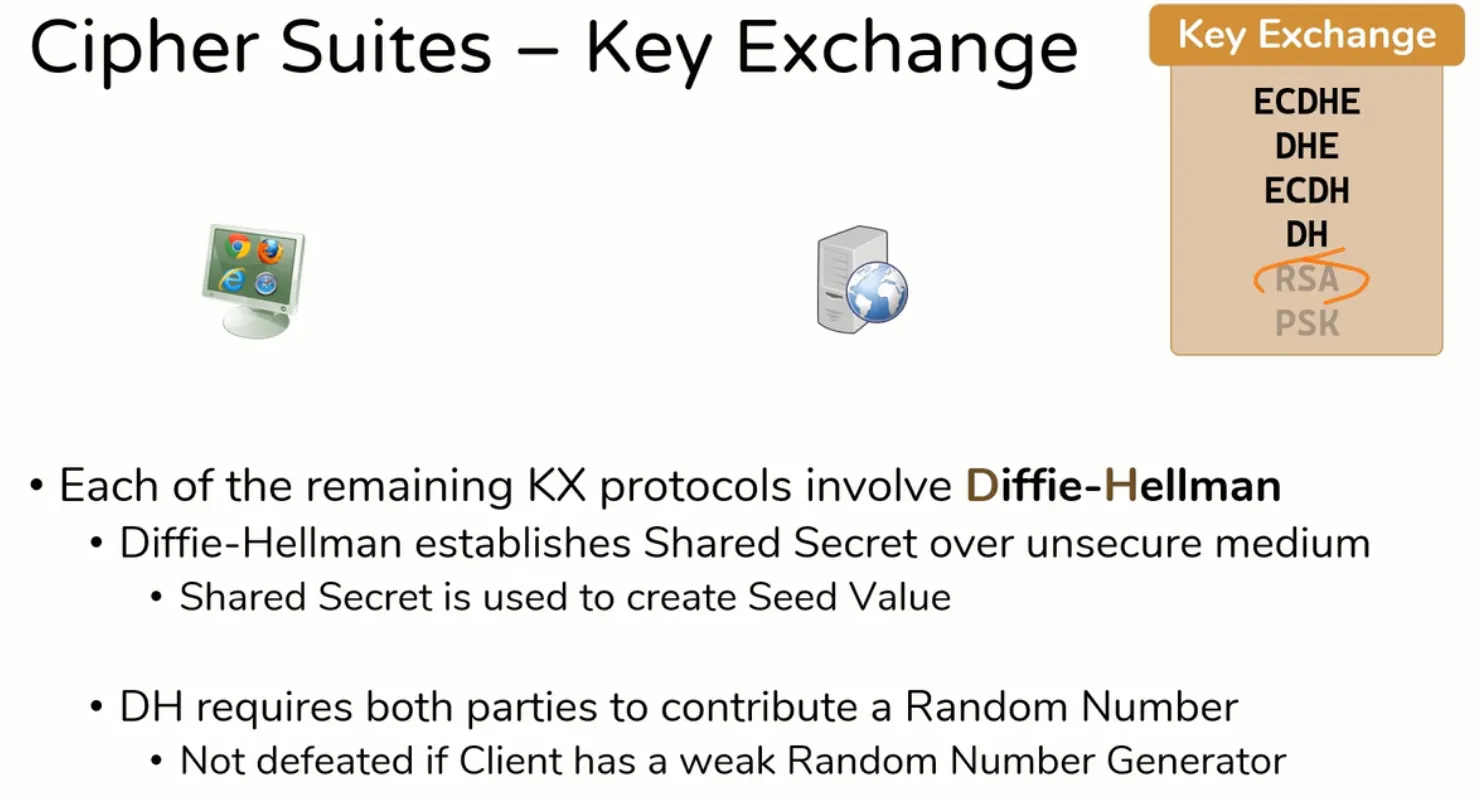
Forward Secrecy
Definition : ” Once encrypted always encrypted ” meaning that asymmetric private key never compromise whether we are using it or not.
Without Forward Secrecy
The
Parameters (P, G, Private Key) are statically stored in private key itselfwhich is not safe because attackerget that private key by chance then it can generate seed valueout of it.
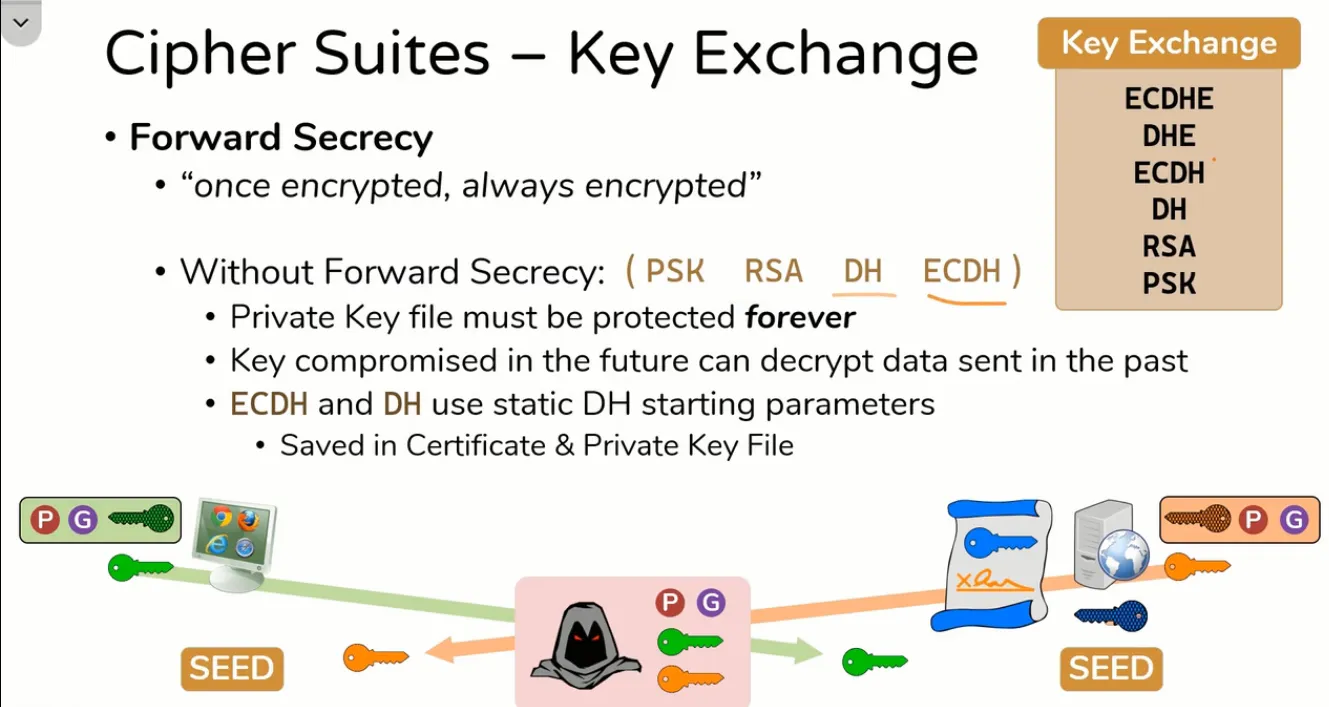
- With Forward Secrecy
- For ECDHE and DHE the Parameters (P, G, Private Key) are
discarded after getting seedvalue so evenif attacker gets the private key it can't get the seed.

Avoid, Accept, Prefer
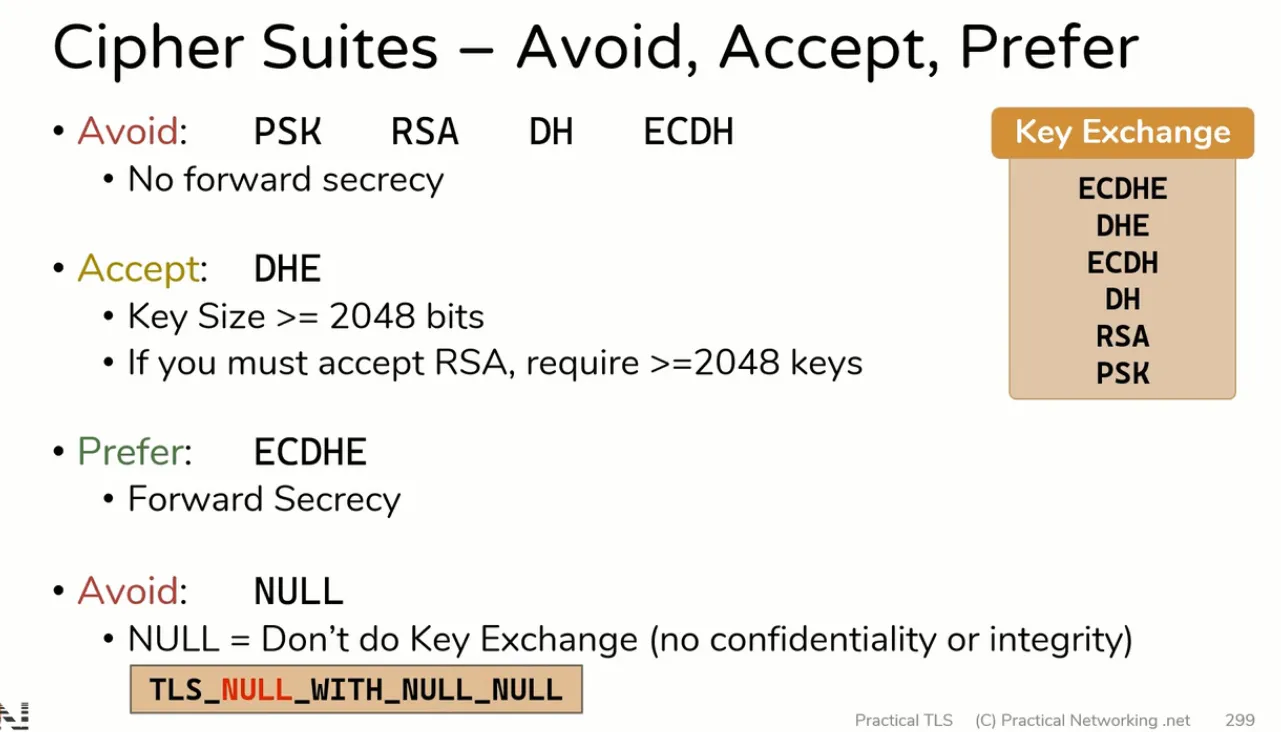
Authentication
- Verify if server is truly who they say are
- Here are numbers of algorithms for authentication,
- PSK
- DSS
- RSA
- ECDSA
PSK
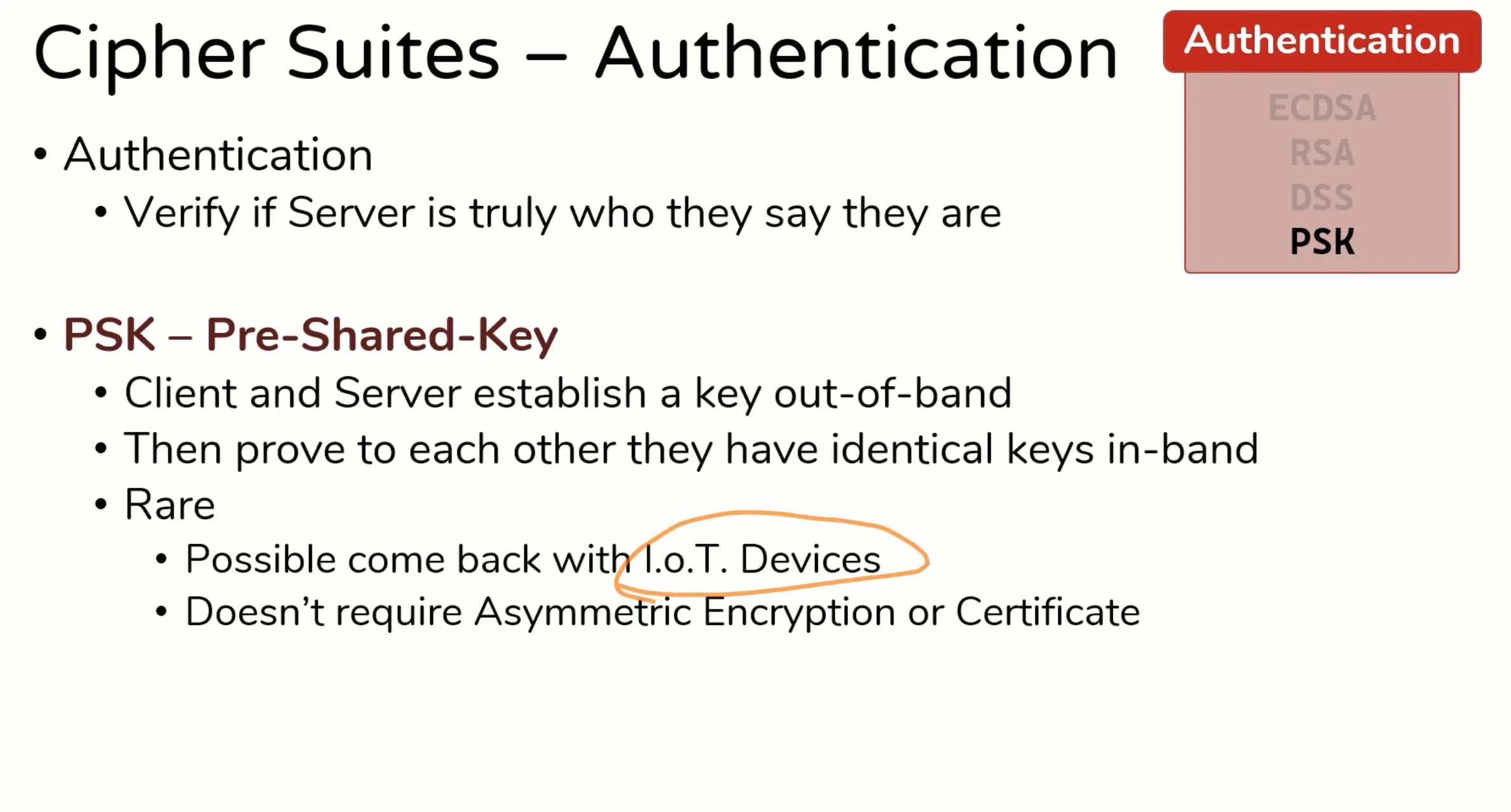
DSS (Digital Signature Standard)
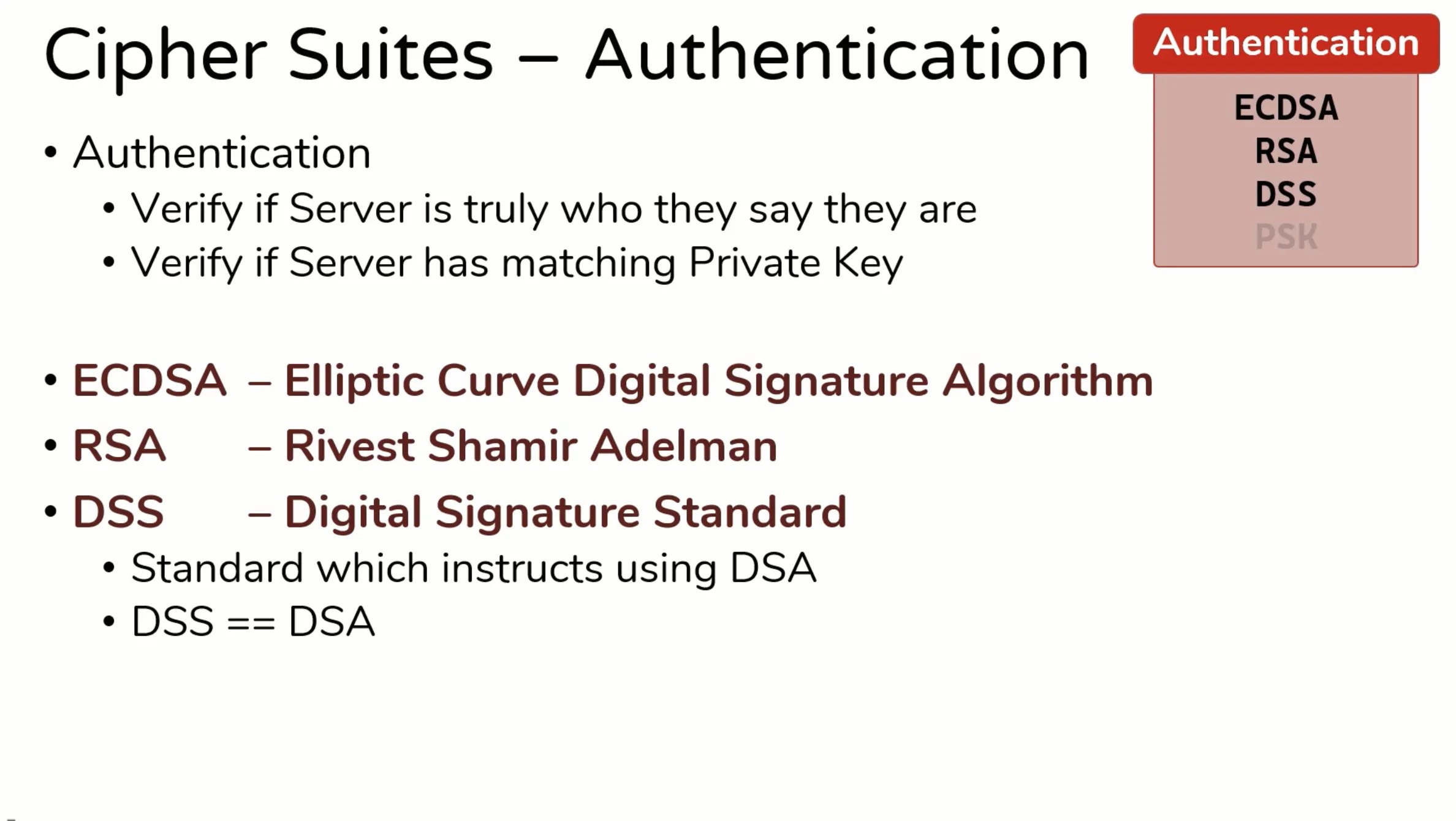
- DSA
- Random Number is very important
- MUST be unique for each message or DSA fails catastrophically
- If Random # is ever re-used, Private Key can be extracted
- RFC 6979 u— Generate random # deterministically based on Message
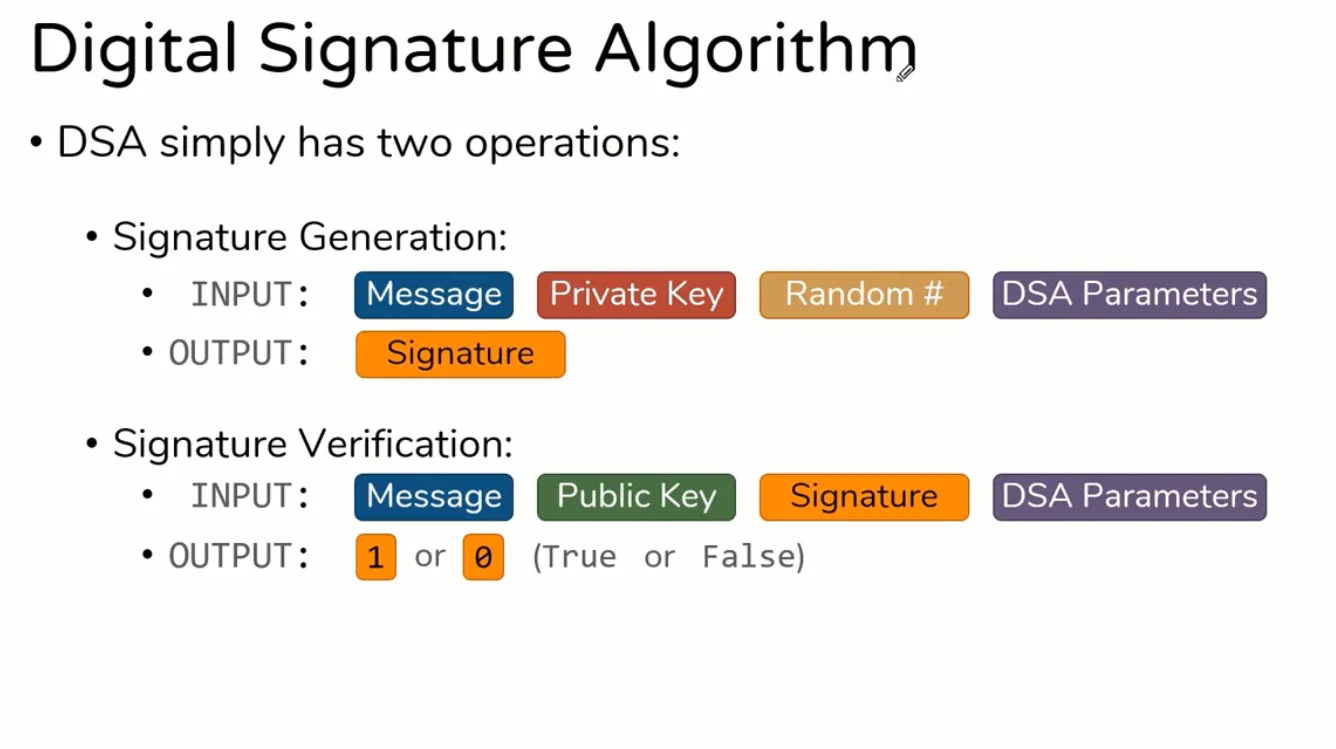
RSA vs DSS (DSA)
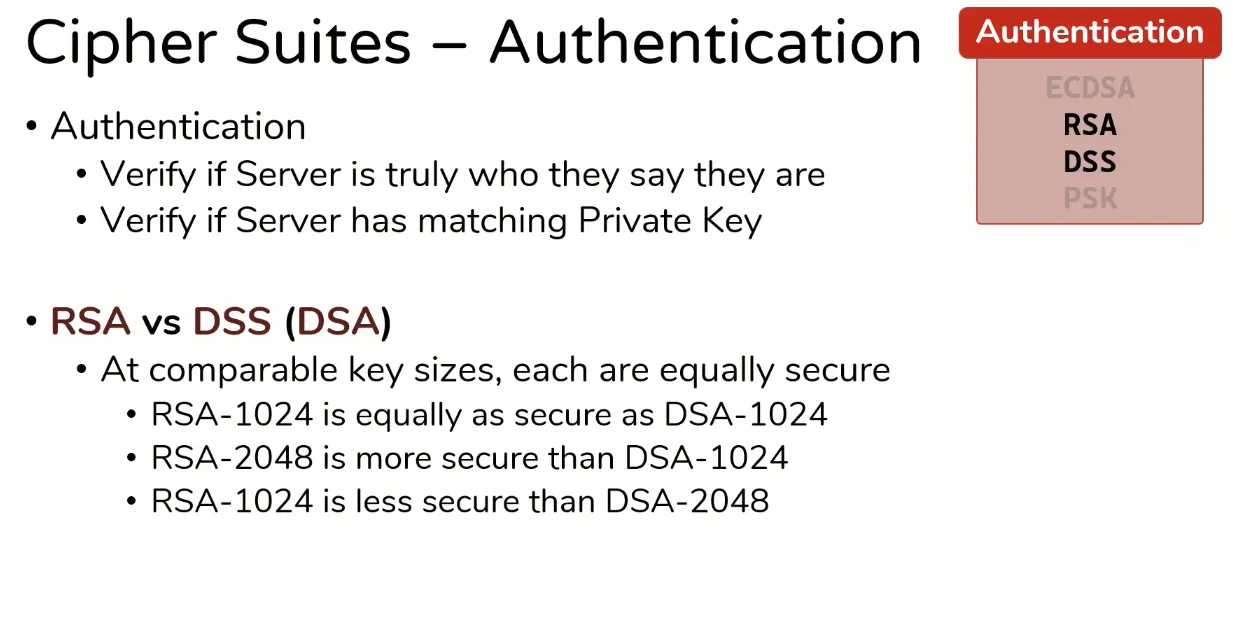
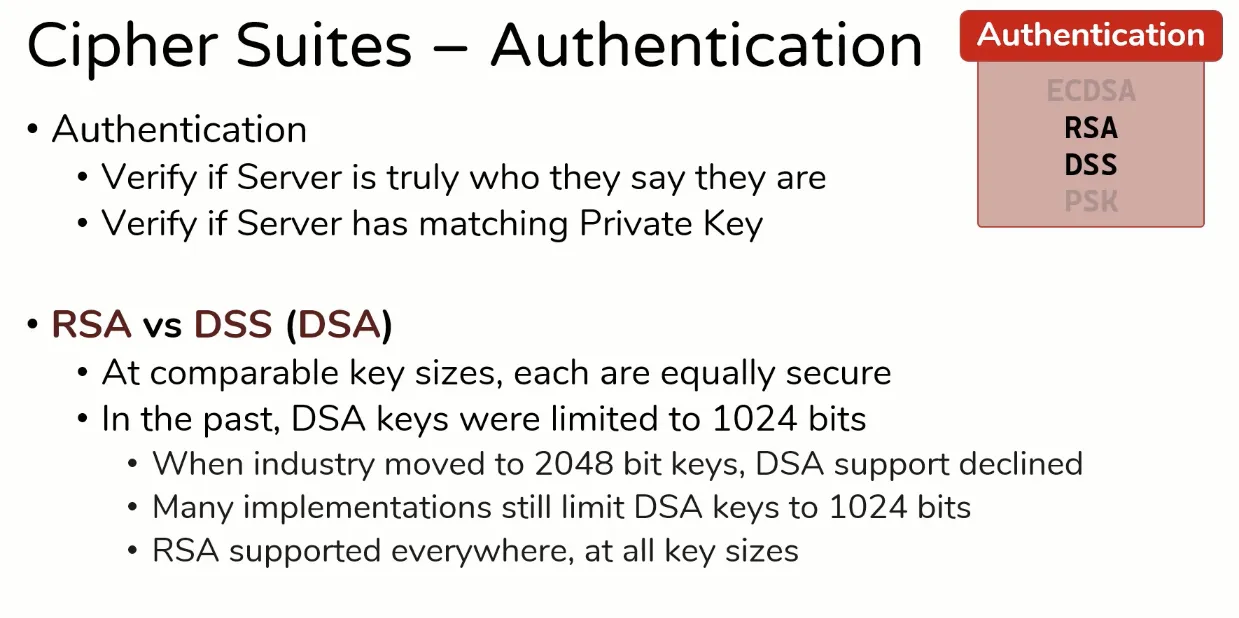
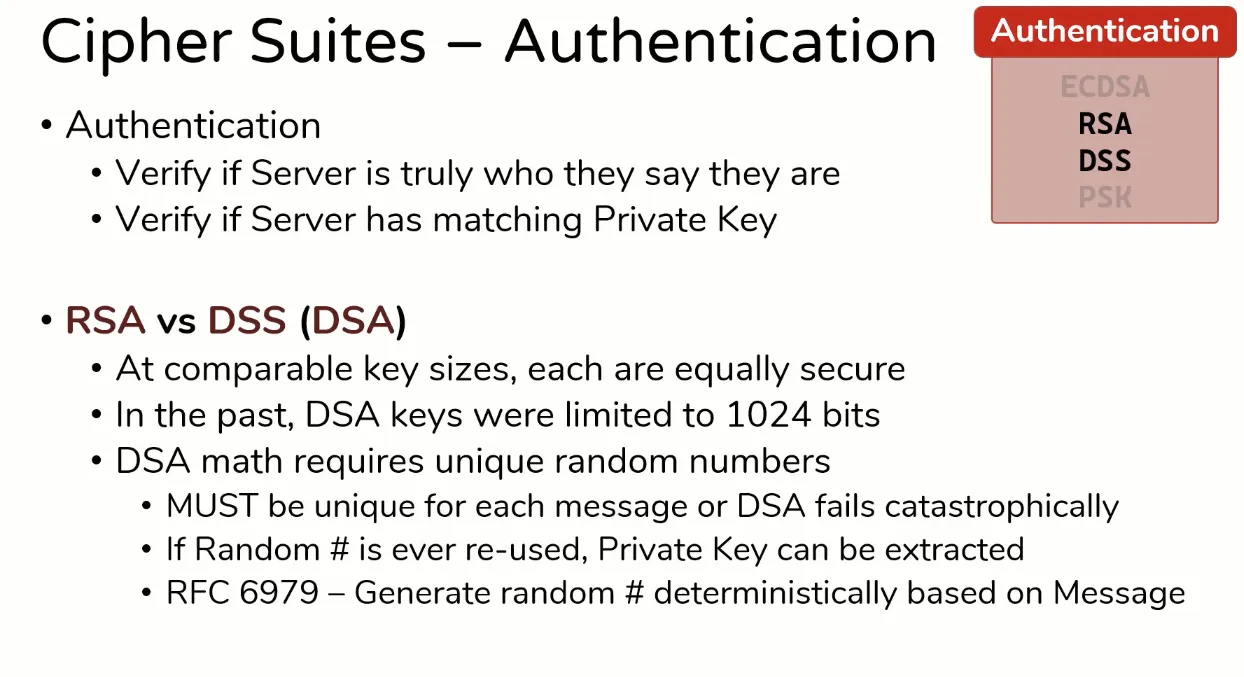
- Summary :- Between RSA and DSS, RSA better performing in terms of security and largely acceptance
RSA vs ECDSA
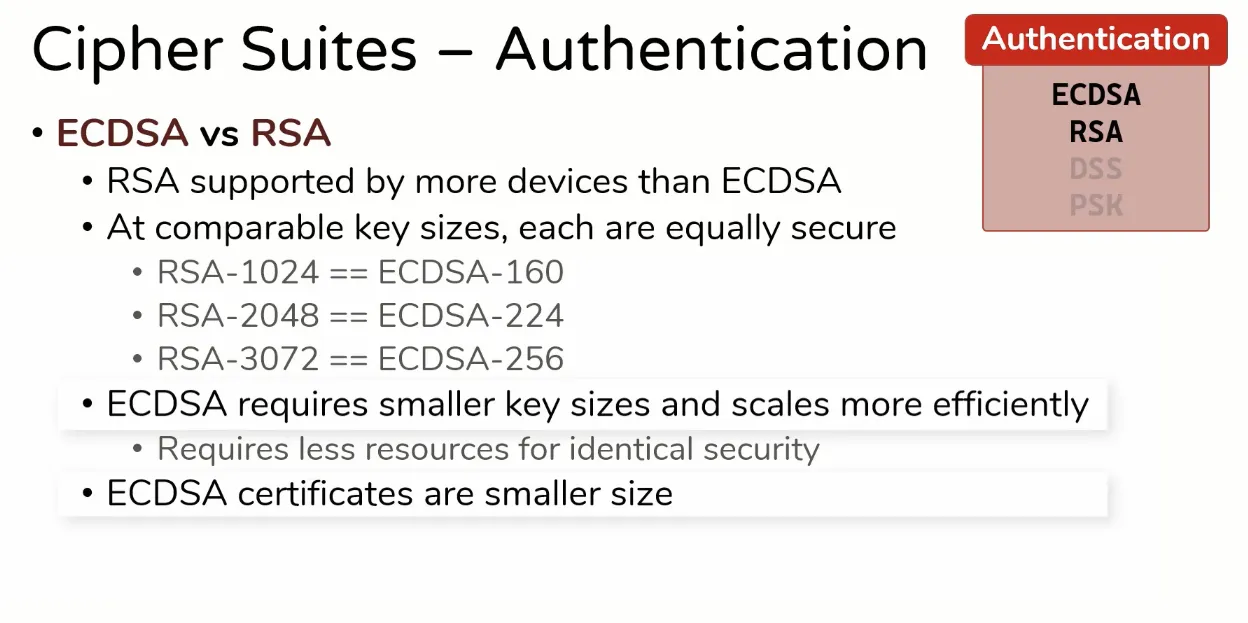
- Summary :- Between RSA and ECDSA .. choose ECDSA
Note >
> BUT, you don't actually have to choose - you can use both!
> Cipher Suite is selected before Certificate is sent
> If client only supports RSA: present RSA certificate
> If client supports RSA or ECDSA: present ECDSA certificate
Avoid, Accept, Prefer
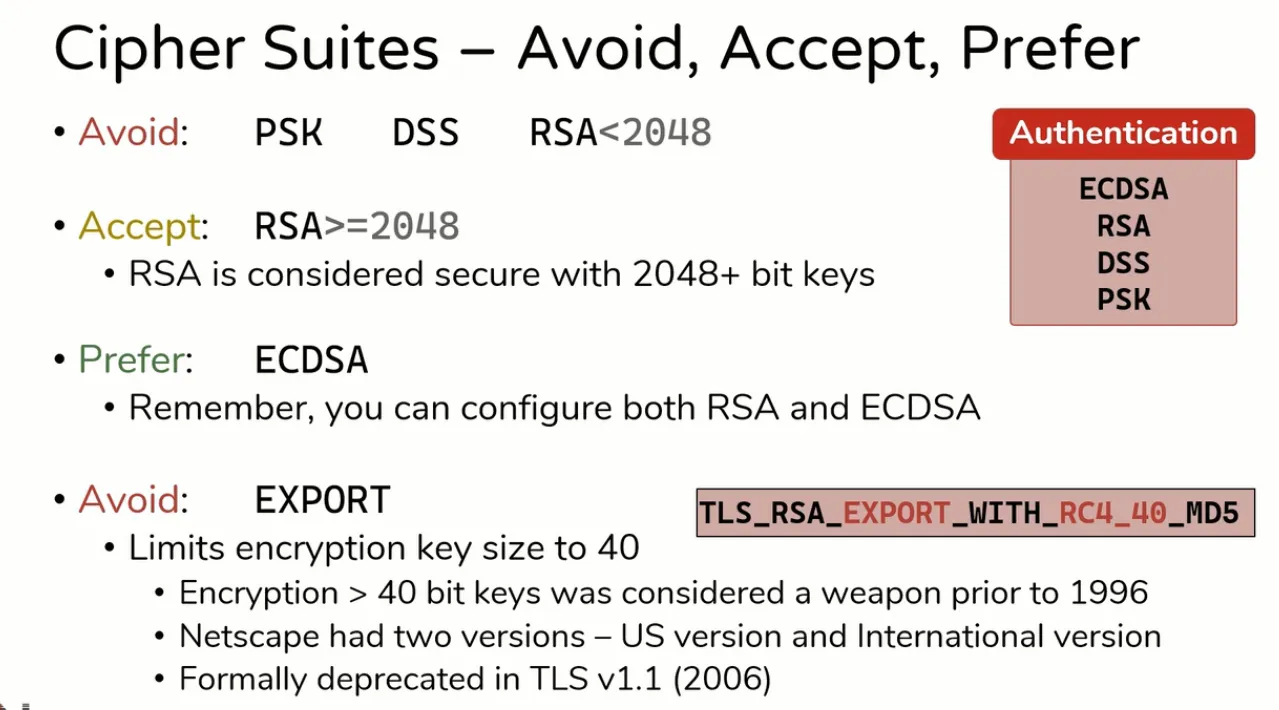
Encryption
- Here are numbers of Encryption algorithms,
- Red: Stream Cipher, Green: Block Cipher
- CHACHA20
- AES-256-GCM
- AES-128-GCM
- AES-256-CBC
- AES-128-CBC
- 3DES-CBC
- RC4-128
- DES-CBC
Key Sizes
< 128 bits : not secure
= 128 bits : secure
> 128 bits : very secure
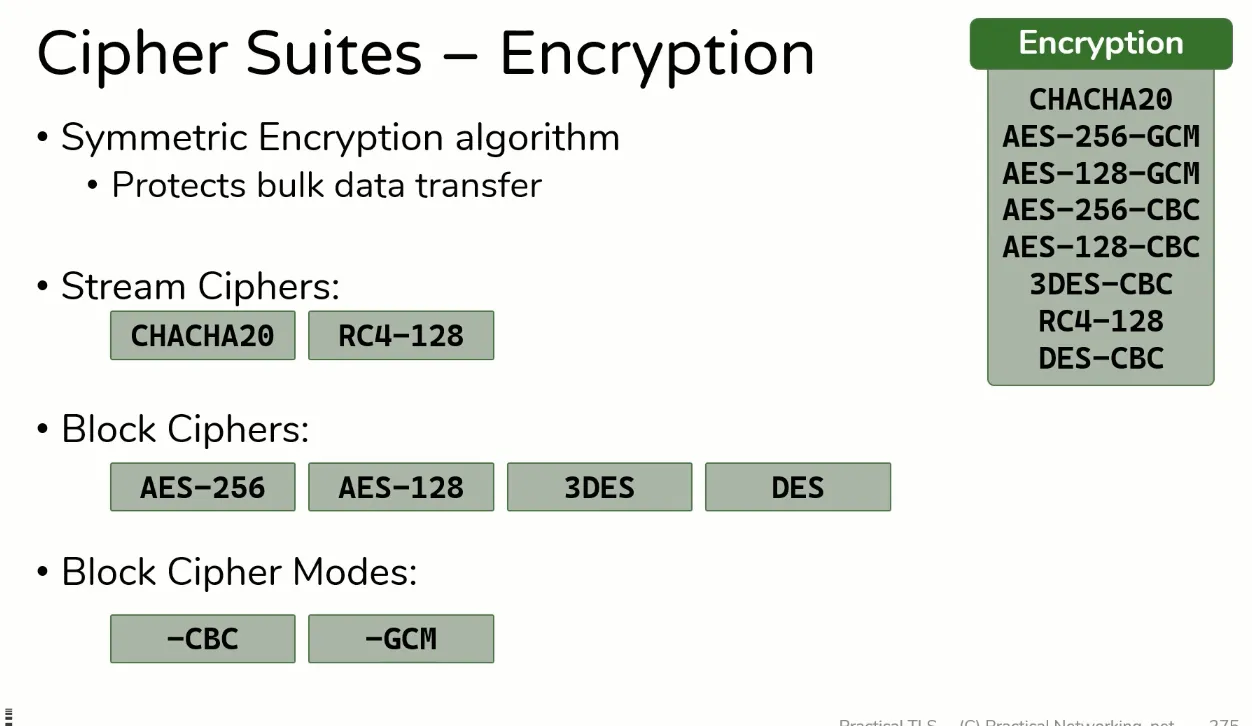
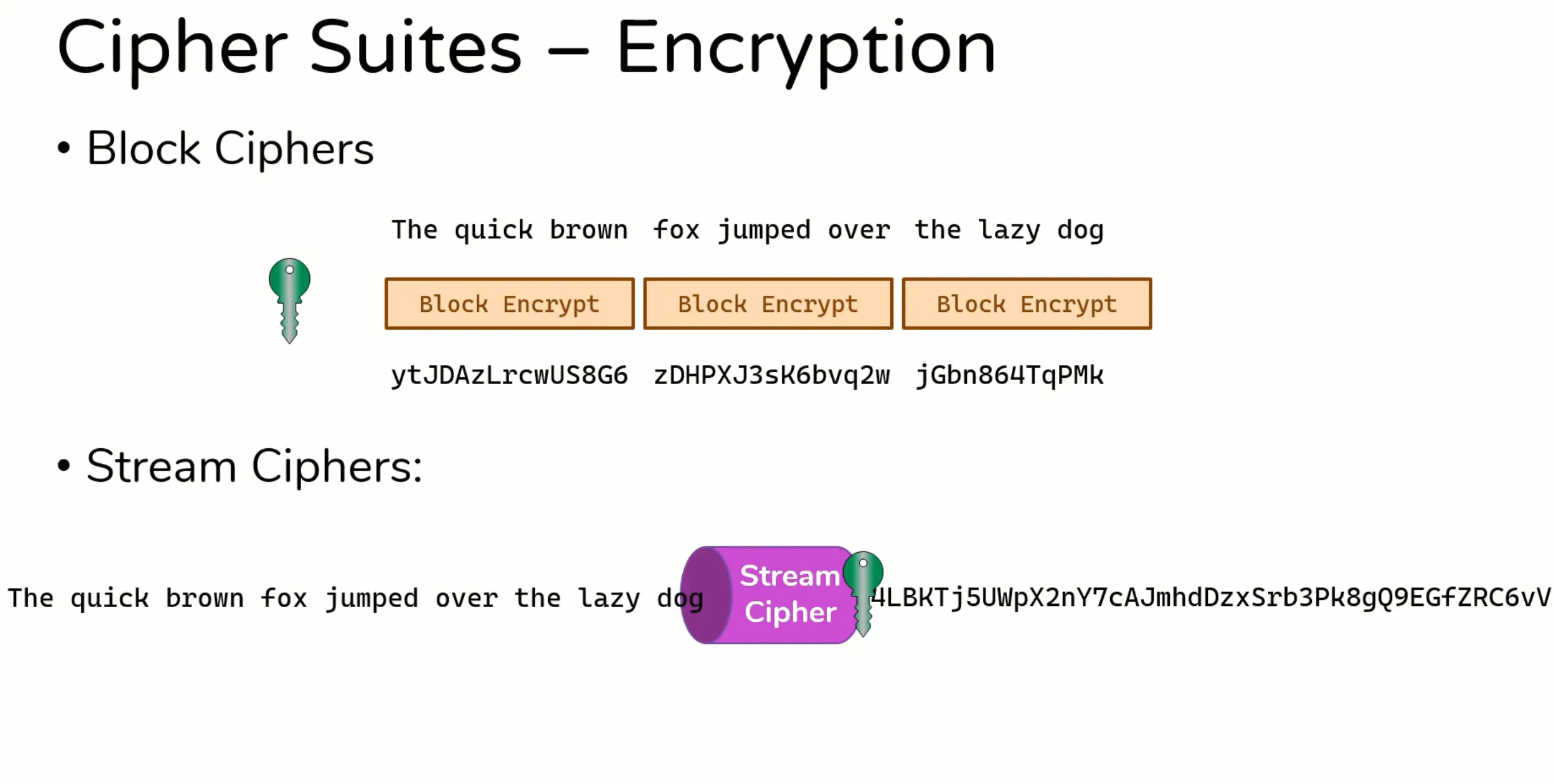
Block cipher vs Stream Cipher
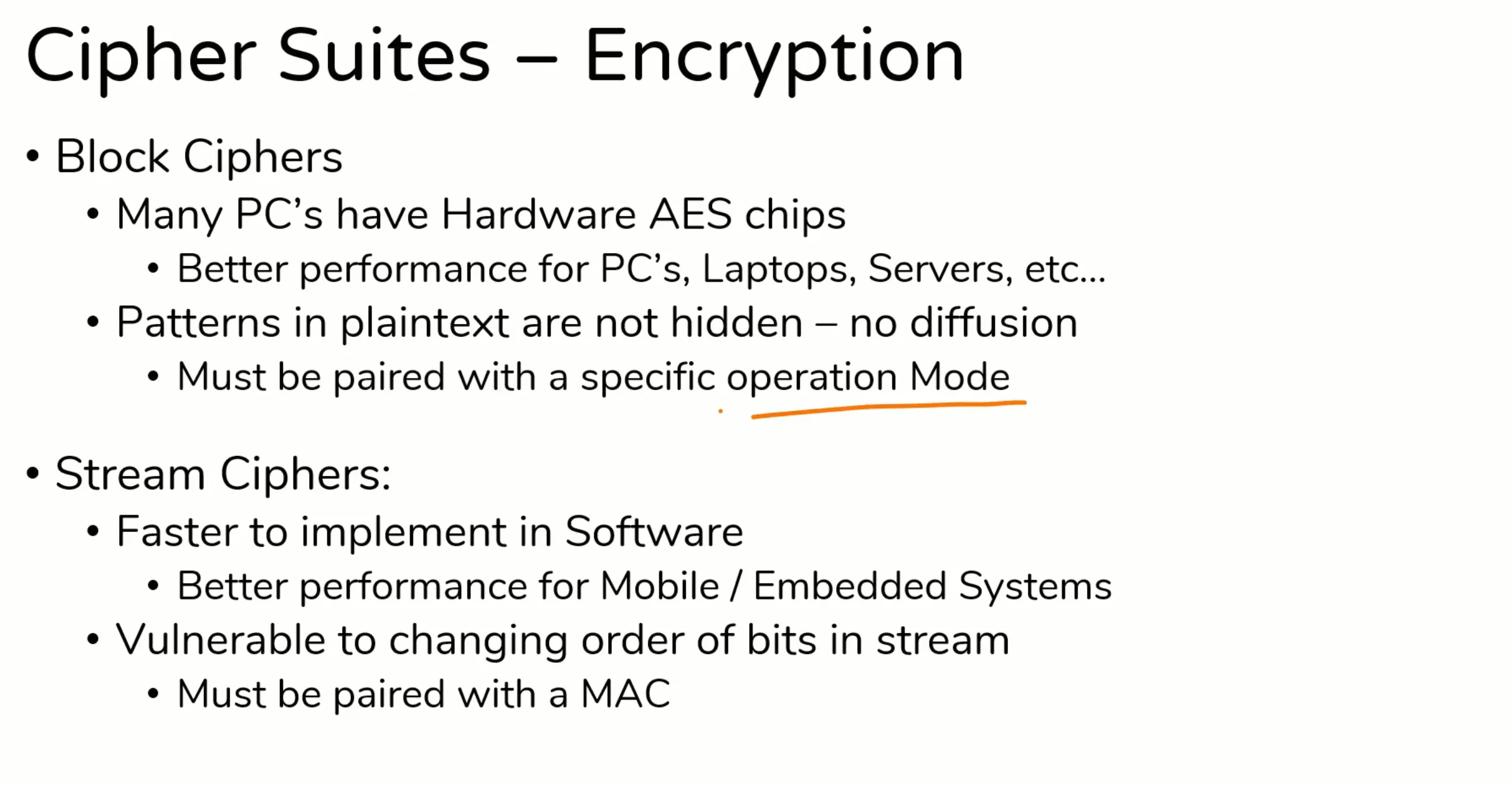
What is Diffusion?
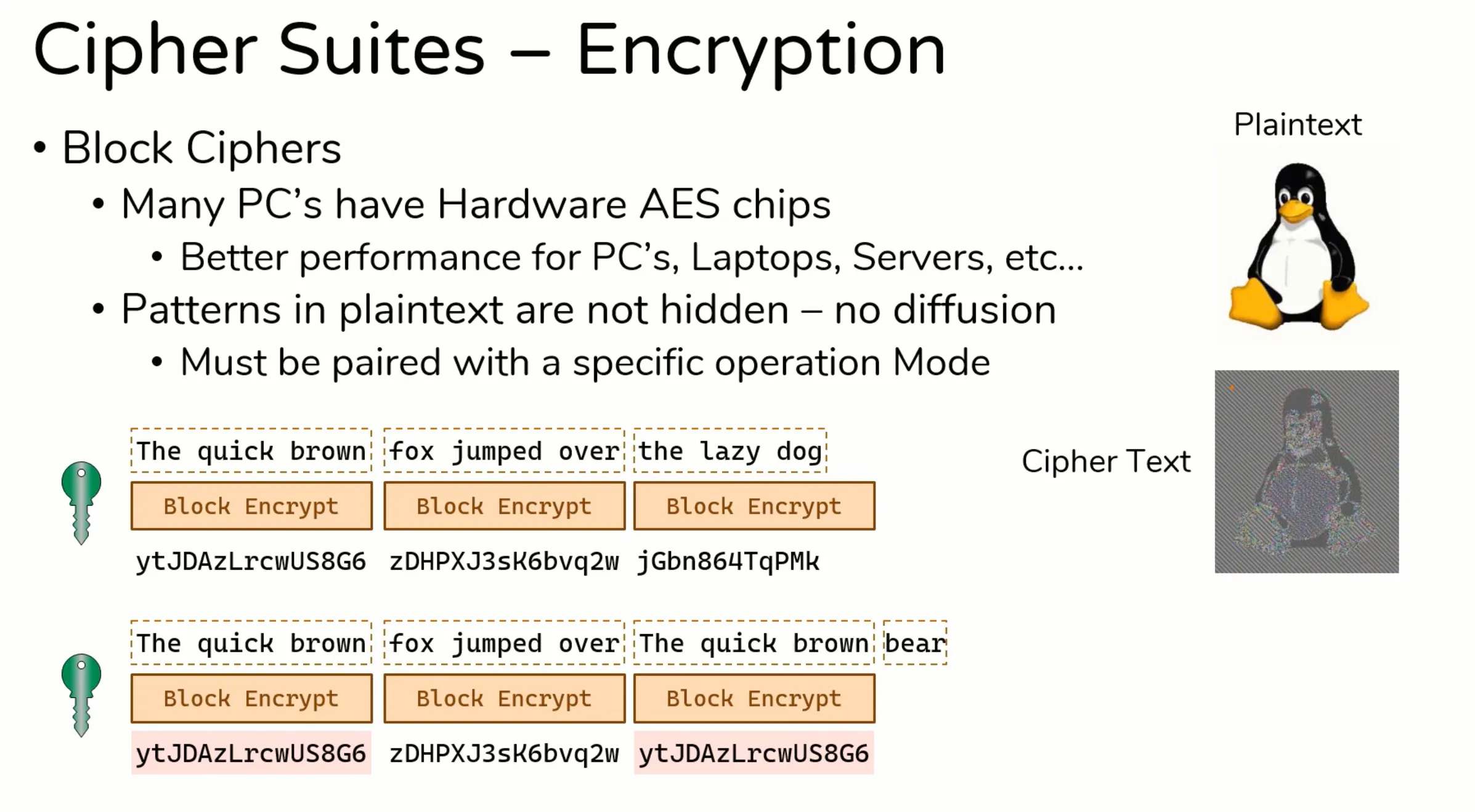
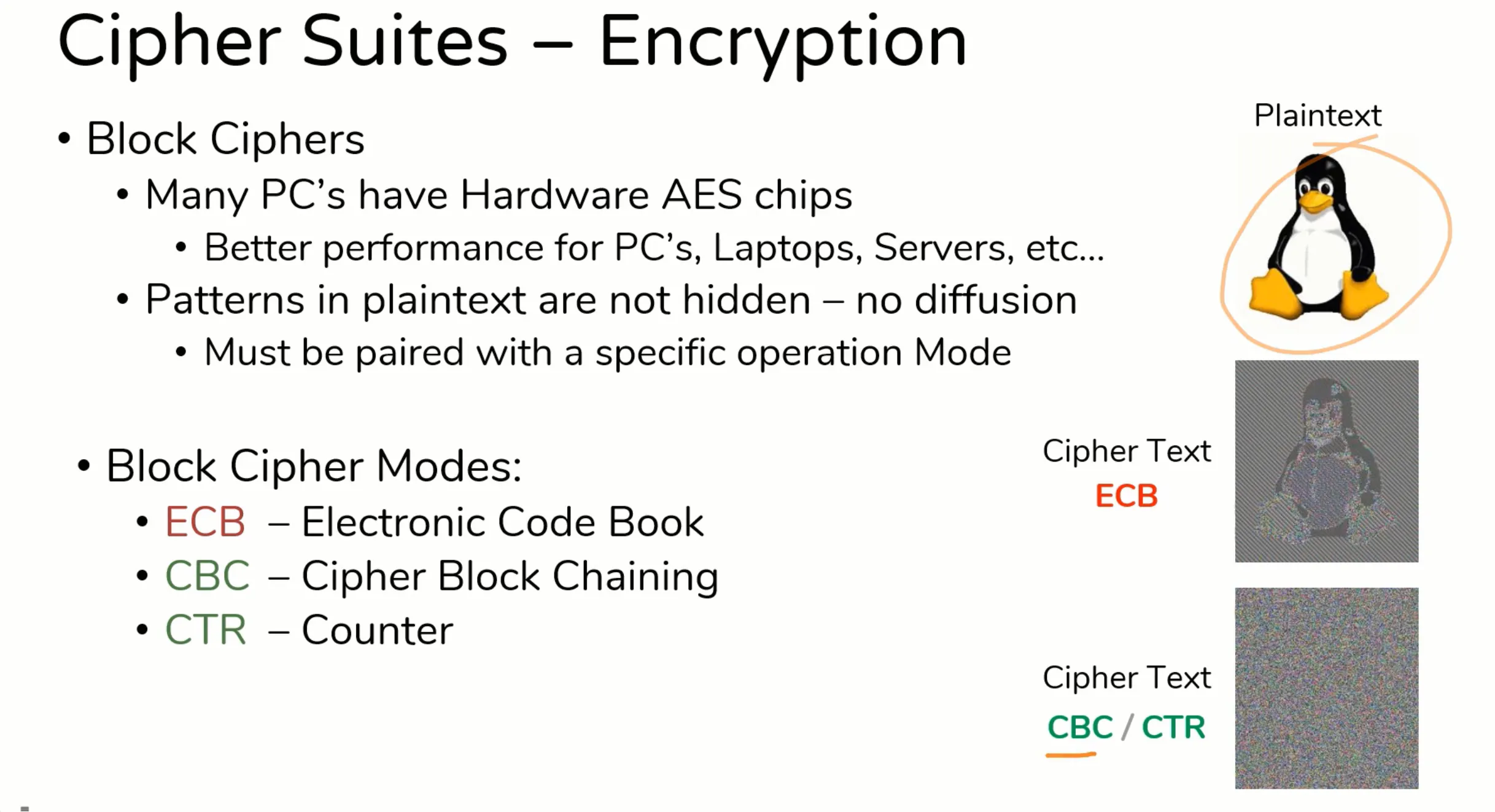
Block Cipher Modes
CBC (Cipher Block Chaining)
it suffers from “padding oracle”
Cannot be parallelized (next block is dependent on previous one makes it slower)
Encryption
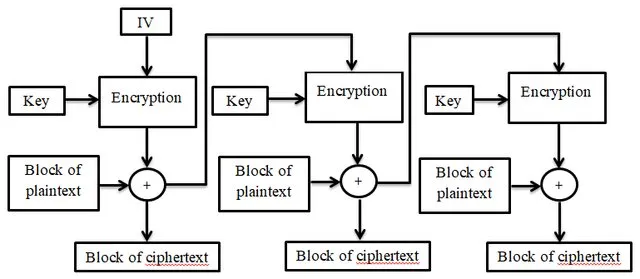
- Decryption
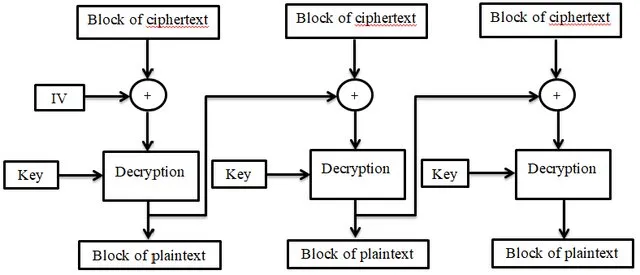
CTR (Counter)
Cipher blocks are not tied to blocks before or after so its vulnerable to changing block in cipher text so must pair with MAC know as Galois Counter Mode (GCM).
its a AEAD (Authenticated Encryption with Associated Data) cipher
- can do
symmetric encryption and MACat the same time
- can do
Can be parallelized
Encryption / Decryption

3DES-CBC, RC4-128, DES-CBC
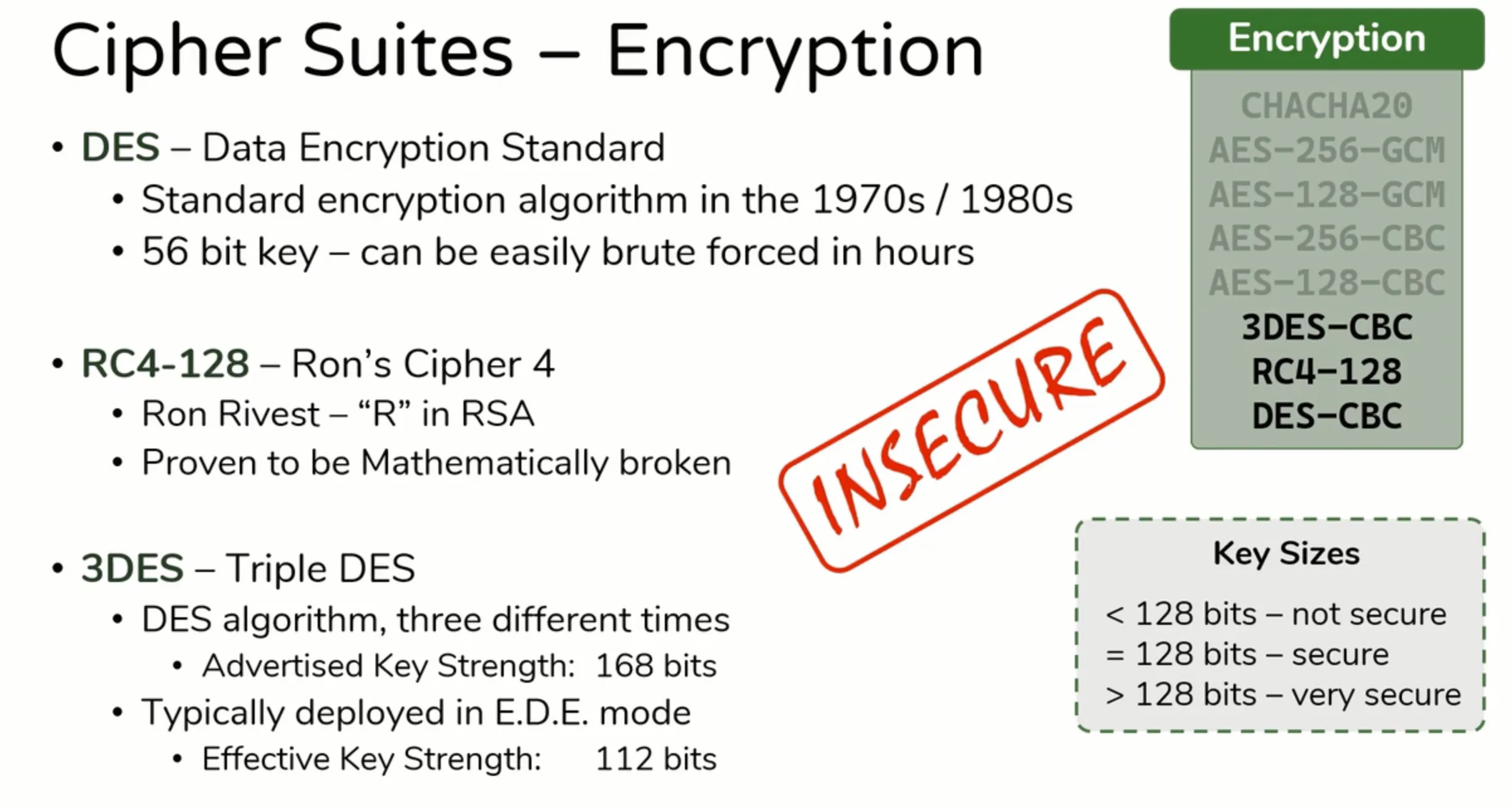
AES-128/256-GCM/CBC
- Given 2 Encryption Algorithms are known to be much secure then other two.
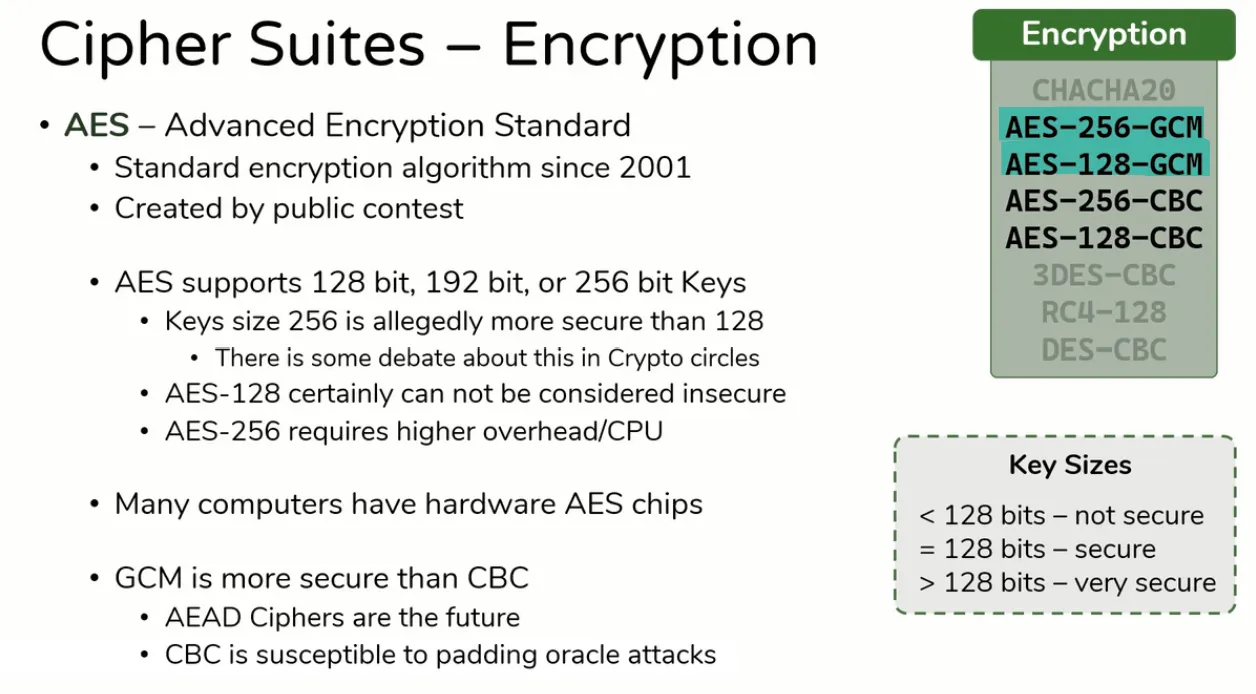
ChaCha20
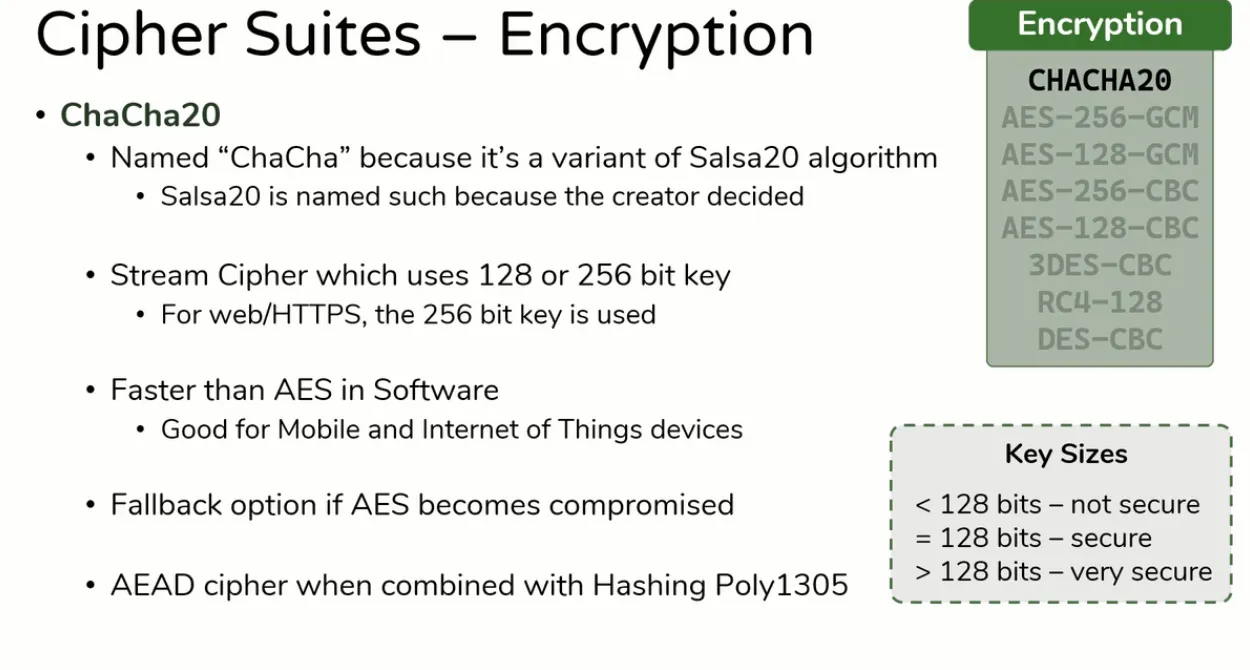
Summarization
- Summary :-
- AEAD (Authenticated Encryption with Associated Data) ciphers provide both
confidentialityandintegrityby combiningencryptionandauthenticationin a single operation. - Examples: ChaCha20-Poly1305, AES-CCM (Counter with CBC-MAC Mode), AES-GCM (Galois/Counter Mode), AES-GCM-SIV (Synthetic Initialization Vector), OCB (Offset Codebook Mode)
- AEAD (Authenticated Encryption with Associated Data) ciphers provide both
Avoid, Accept, Prefer
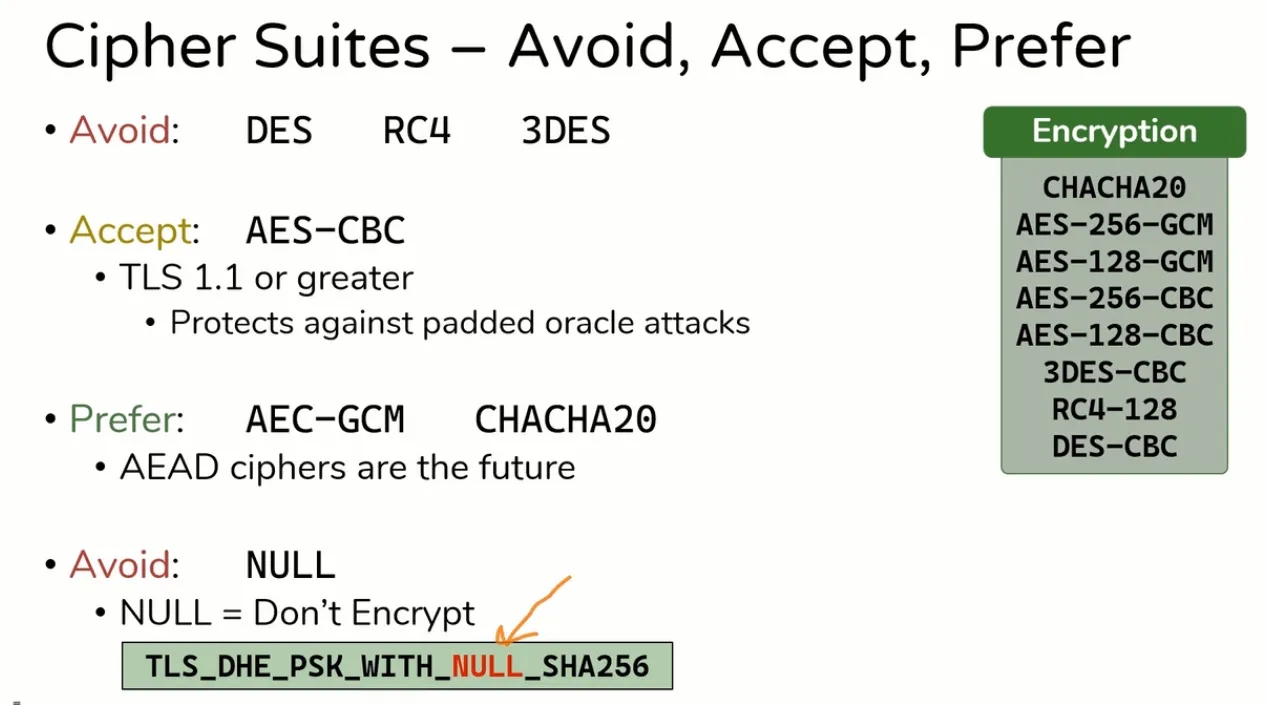
Hashing
- Hashing algorithm which will be used as a MAC (Message Authentication Code) Provides Integrity and Authentication for Bulk Data
- Poty1305
- SHA384
- SHA256
- SHA
- MD5
MD5
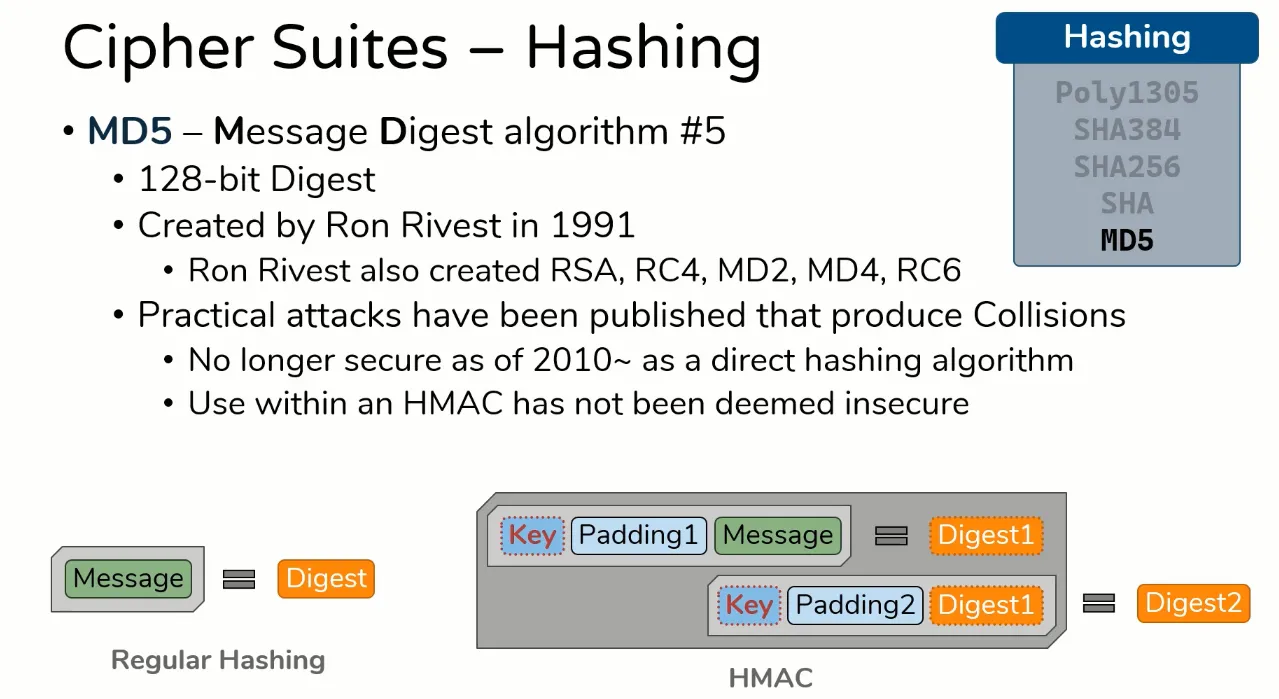
SHA-1/256/384/512
- SHA1 Family
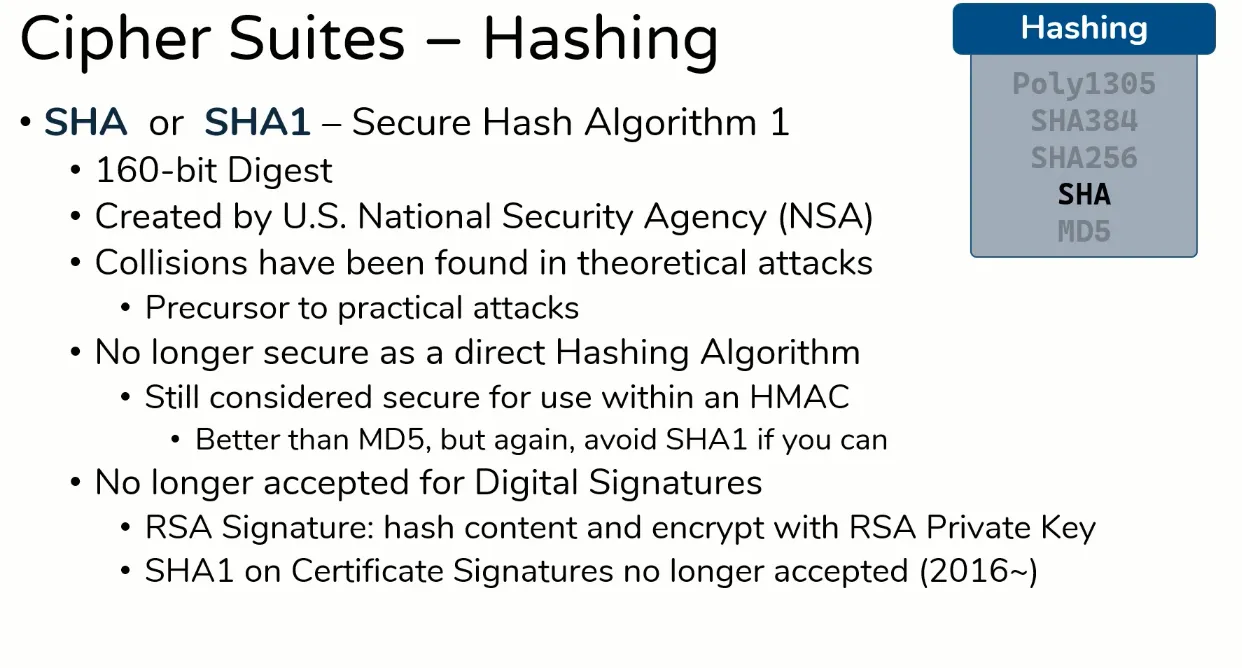
- SHA-2 Family
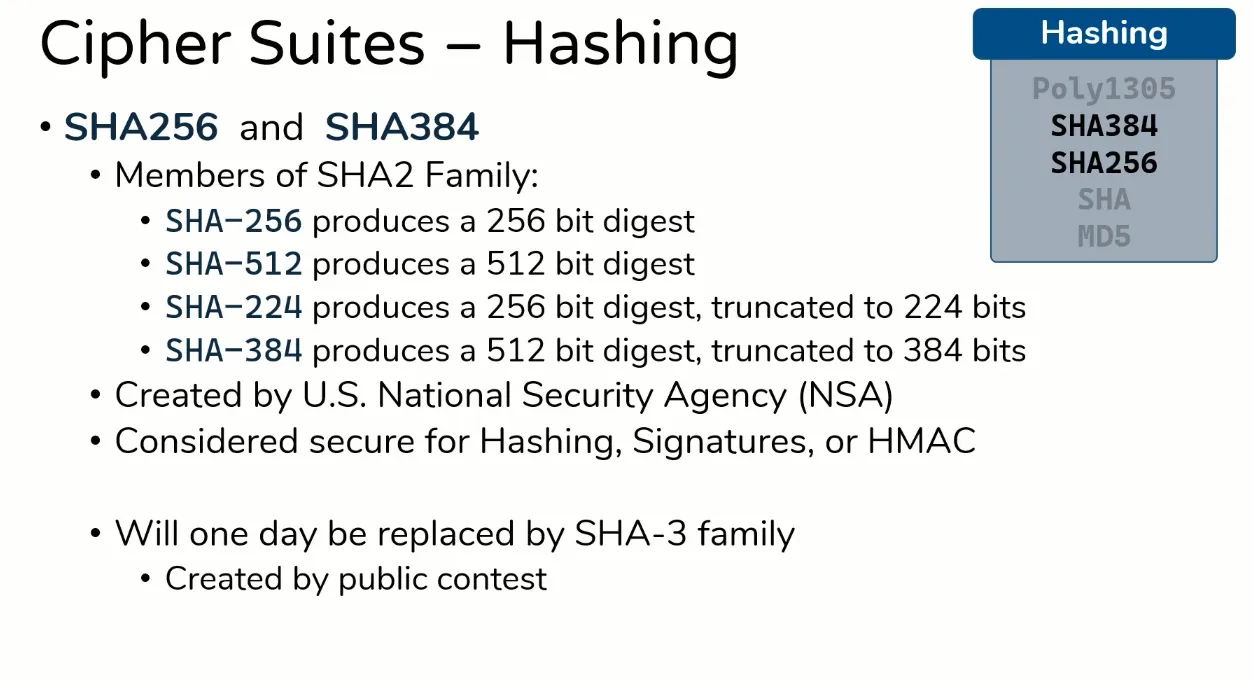
Poly1305
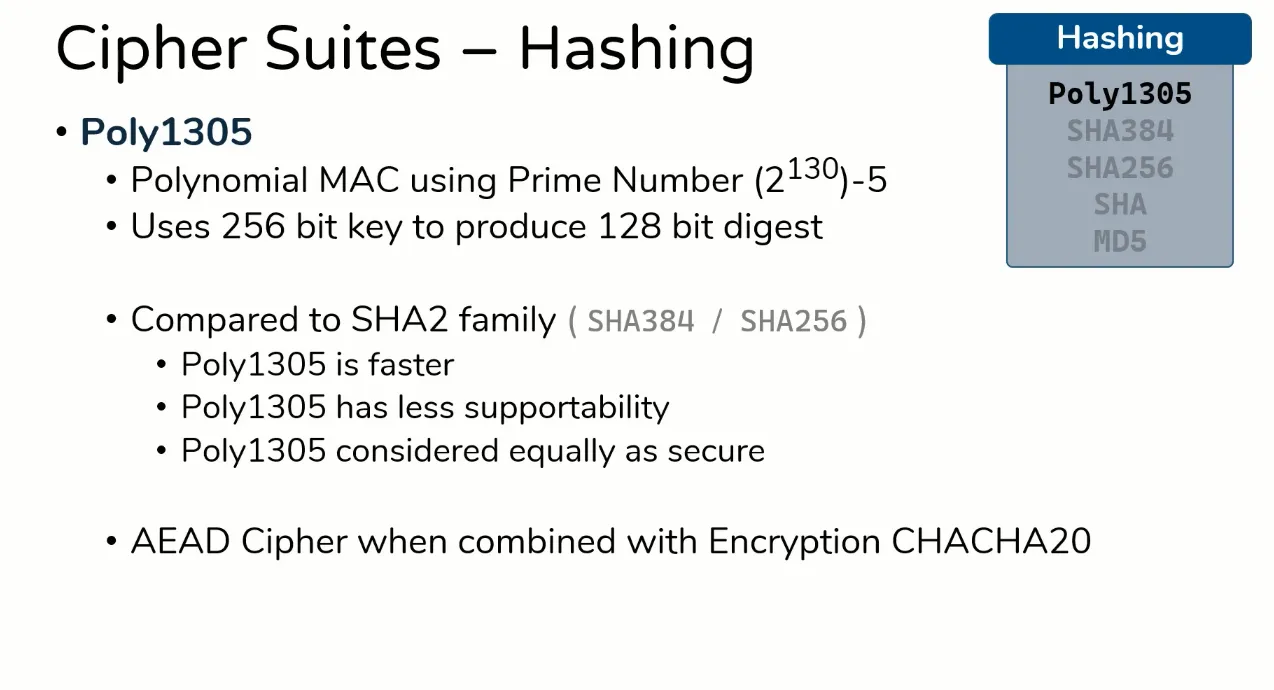
Avoid, Accept, Prefer
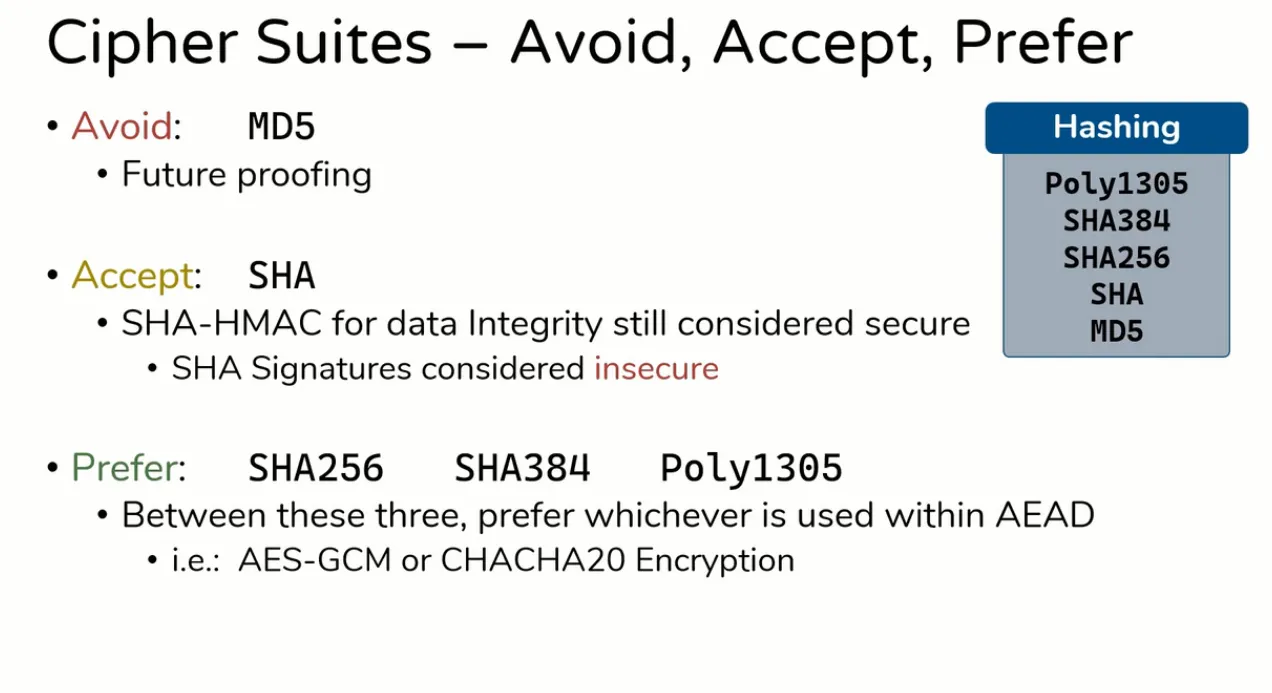
Cipher Suites Task
Netflix Cipher Suite Analysis
Starting Nmap 7.94SVN ( https://nmap.org ) at 2025-02-23 00:28 IST
Nmap scan report for netflix.com (54.73.148.110)
Host is up (0.16s latency).
Other addresses for netflix.com (not scanned): 18.200.8.190 54.155.246.232 2a05:d018:76c:b685:c898:aa3a:42c7:9d21 2a05:d018:76c:b684:b233:ac1f:be1f:7 2a05:d018:76c:b683:e1fe:9fbf:c403:57f1
rDNS record for 54.73.148.110: ec2-54-73-148-110.eu-west-1.compute.amazonaws.com
PORT STATE SERVICE VERSION
443/tcp open ssl/http-proxy (bad gateway)
| ssl-enum-ciphers:
| TLSv1.0:
| ciphers:
| TLS_ECDHE_RSA_WITH_AES_128_CBC_SHA (ecdh_x25519) - A
| TLS_ECDHE_RSA_WITH_AES_256_CBC_SHA (ecdh_x25519) - A
| TLS_RSA_WITH_AES_128_CBC_SHA (rsa 2048) - A
| TLS_RSA_WITH_AES_256_CBC_SHA (rsa 2048) - A
| compressors:
| NULL
| cipher preference: server
| TLSv1.1:
| ciphers:
| TLS_ECDHE_RSA_WITH_AES_128_CBC_SHA (ecdh_x25519) - A
| TLS_ECDHE_RSA_WITH_AES_256_CBC_SHA (ecdh_x25519) - A
| TLS_RSA_WITH_AES_128_CBC_SHA (rsa 2048) - A
| TLS_RSA_WITH_AES_256_CBC_SHA (rsa 2048) - A
| compressors:
| NULL
| cipher preference: server
| TLSv1.2:
| ciphers:
| TLS_ECDHE_RSA_WITH_AES_128_GCM_SHA256 (ecdh_x25519) - A
| TLS_ECDHE_RSA_WITH_AES_256_GCM_SHA384 (ecdh_x25519) - A
| TLS_ECDHE_RSA_WITH_AES_128_CBC_SHA (ecdh_x25519) - A
| TLS_ECDHE_RSA_WITH_AES_256_CBC_SHA (ecdh_x25519) - A
| TLS_RSA_WITH_AES_128_GCM_SHA256 (rsa 2048) - A
| TLS_RSA_WITH_AES_128_CBC_SHA (rsa 2048) - A
| TLS_RSA_WITH_AES_256_GCM_SHA384 (rsa 2048) - A
| TLS_RSA_WITH_AES_256_CBC_SHA (rsa 2048) - A
| compressors:
| NULL
| cipher preference: server
| TLSv1.3:
| ciphers:
| TLS_AKE_WITH_AES_128_GCM_SHA256 (ecdh_x25519) - A
| TLS_AKE_WITH_AES_256_GCM_SHA384 (ecdh_x25519) - A
| TLS_AKE_WITH_CHACHA20_POLY1305_SHA256 (ecdh_x25519) - A
| cipher preference: client
|_ least strength: A
|_http-server-header: envoy
| fingerprint-strings:
| FourOhFourRequest:
| HTTP/1.1 502 Bad Gateway
| Via: 1.1 i-0aba3ec878b310dc9 (eu-west-1)
| X-Originating-URL: https://100.86.75.66/nice%20ports%2C/Tri%6Eity.txt%2ebak
| Set-Cookie: nfvdid=BQFmAAEBEIdGmZncsdqD_2VD-Pr0zWJA9x9aJw1FMTZTb0NkJIQPaAs0R5lb3RYJrtJSa6ZebRN9sSeehEbz9cV_qcrsSAAn9GHxBxPeslAht6l9IVBBeg%3D%3D; Domain=.netflix.com; Path=/; Max-Age=31536000
| X-Netflix.nfstatus: 2_16
| X-Netflix.proxy.execution-time: 1378
| transfer-encoding: chunked
| Connection: close
| GetRequest:
| HTTP/1.1 404 Not Found
| Content-Length: 7
| Connection: close
| BLOCKED
| HTTPOptions:
| HTTP/1.1 200 OK
| Content-Length: 0
| Access-Control-Allow-Origin: *
| Access-Control-Allow-Credentials: true
| Allow: GET, HEAD, POST, PUT, DELETE, TRACE, OPTIONS, SCRIPT
| Access-Control-Allow-Methods: GET, HEAD, POST, PUT, DELETE, TRACE, OPTIONS, SCRIPT
| Accept-CH: Sec-CH-UA-Model,Sec-CH-UA-Platform-Version
|_ Access-Control-Allow-Headers: Authorization,Content-Type,Content-Encoding,Accept,X-Netflix.application.name,X-Netflix.application.version,X-Netflix.esn,X-Netflix.device.type,X-Netflix.certification.version,X-Netflix.request.uuid,X-Netflix.originating.request.uuid,X-Netflix.user.id,X-Netflix.oauth.consumer.key,X-Netflix.oauth.token,X-Netflix.ichnaea.request.type,X-Netflix.Request.Routing,X-NETFLIX-PREAPP-PARTNER-ID,X-NETFLIX-PREAPP-INTEGRITY-VALUE,X-Netflix.Request.Priority,X-Netflix.Retry.Client.Policy,X-Netflix.Client.Request.Name,X-Netflix.Request.Retry.Policy,X-Netflix.Request.Retry
1 service unrecognized despite returning data. If you know the service/version, please submit the following fingerprint at https://nmap.org/cgi-bin/submit.cgi?new-service :
SF-Port443-TCP:V=7.94SVN%T=SSL%I=7%D=2/23%Time=67BA1E7B%P=x86_64-pc-linux-
SF:gnu%r(GetRequest,47,"HTTP/1\.1\x20404\x20Not\x20Found\r\nContent-Length
SF::\x207\r\nConnection:\x20close\r\n\r\nBLOCKED")%r(HTTPOptions,893,"HTTP
SF:/1\.1\x20200\x20OK\r\nContent-Length:\x200\r\nAccess-Control-Allow-Orig
SF:in:\x20\*\r\nAccess-Control-Allow-Credentials:\x20true\r\nAllow:\x20GET
SF:,\x20HEAD,\x20POST,\x20PUT,\x20DELETE,\x20TRACE,\x20OPTIONS,\x20SCRIPT\
SF:r\nAccess-Control-Allow-Methods:\x20GET,\x20HEAD,\x20POST,\x20PUT,\x20D
SF:ELETE,\x20TRACE,\x20OPTIONS,\x20SCRIPT\r\nAccept-CH:\x20Sec-CH-UA-Model
SF:,Sec-CH-UA-Platform-Version\r\nAccess-Control-Allow-Headers:\x20Authori
SF:zation,Content-Type,Content-Encoding,Accept,X-Netflix\.application\.nam
SF:e,X-Netflix\.application\.version,X-Netflix\.esn,X-Netflix\.device\.typ
SF:e,X-Netflix\.certification\.version,X-Netflix\.request\.uuid,X-Netflix\
SF:.originating\.request\.uuid,X-Netflix\.user\.id,X-Netflix\.oauth\.consu
SF:mer\.key,X-Netflix\.oauth\.token,X-Netflix\.ichnaea\.request\.type,X-Ne
SF:tflix\.Request\.Routing,X-NETFLIX-PREAPP-PARTNER-ID,X-NETFLIX-PREAPP-IN
SF:TEGRITY-VALUE,X-Netflix\.Request\.Priority,X-Netflix\.Retry\.Client\.Po
SF:licy,X-Netflix\.Client\.Request\.Name,X-Netflix\.Request\.Retry\.Policy
SF:,X-Netflix\.Request\.Retry")%r(FourOhFourRequest,1C7,"HTTP/1\.1\x20502\
SF:x20Bad\x20Gateway\r\nVia:\x201\.1\x20i-0aba3ec878b310dc9\x20\(eu-west-1
SF:\)\r\nX-Originating-URL:\x20https://100\.86\.75\.66/nice%20ports%2C/Tri
SF:%6Eity\.txt%2ebak\r\nSet-Cookie:\x20nfvdid=BQFmAAEBEIdGmZncsdqD_2VD-Pr0
SF:zWJA9x9aJw1FMTZTb0NkJIQPaAs0R5lb3RYJrtJSa6ZebRN9sSeehEbz9cV_qcrsSAAn9GH
SF:xBxPeslAht6l9IVBBeg%3D%3D;\x20Domain=\.netflix\.com;\x20Path=/;\x20Max-
SF:Age=31536000\r\nX-Netflix\.nfstatus:\x202_16\r\nX-Netflix\.proxy\.execu
SF:tion-time:\x201378\r\ntransfer-encoding:\x20chunked\r\nConnection:\x20c
SF:lose\r\n\r\n0\r\n\r\n");
Service detection performed. Please report any incorrect results at https://nmap.org/submit/ .
Nmap done: 1 IP address (1 host up) scanned in 37.05 seconds
- TLSv1.3 (Most Secure)
- Client Side Cipher Suites
TLS_AKE_WITH_AES_128_GCM_SHA256(ecdh_x25519) - Grade ATLS_AKE_WITH_AES_256_GCM_SHA384(ecdh_x25519) - Grade ATLS_AKE_WITH_CHACHA20_POLY1305_SHA256(ecdh_x25519) - Grade A
- ✅ Security Notes:
- TLS 1.3 removes all weak ciphers and uses only AEAD encryption (AES-GCM, ChaCha20).
- No RSA key exchange (only ECDHE, which supports forward secrecy).
- TLS 1.3 cipher preference is client-driven, unlike earlier versions.
- TLSv1.2 (Secure)
- Server-Proposed Cipher Suites
TLS_ECDHE_RSA_WITH_AES_128_GCM_SHA256(ecdh_x25519) - Grade ATLS_ECDHE_RSA_WITH_AES_256_GCM_SHA384(ecdh_x25519) - Grade ATLS_ECDHE_RSA_WITH_AES_128_CBC_SHA(ecdh_x25519) - Grade ATLS_ECDHE_RSA_WITH_AES_256_CBC_SHA(ecdh_x25519) - Grade ATLS_RSA_WITH_AES_128_GCM_SHA256(rsa 2048) - Grade ATLS_RSA_WITH_AES_256_GCM_SHA384(rsa 2048) - Grade ATLS_RSA_WITH_AES_128_CBC_SHA(rsa 2048) - Grade ATLS_RSA_WITH_AES_256_CBC_SHA(rsa 2048) - Grade A
- ✅ Security Notes:
- TLS 1.2 supports modern cryptographic algorithms (AES-GCM).
- AES-CBC is not ideal due to previous padding oracle vulnerabilities.
- RSA-based key exchange is not forward secure, but ECDHE provides forward secrecy..
- TLSv1.0 (Insecure & Deprecated)
- Server-Proposed Cipher Suites:
TLS_ECDHE_RSA_WITH_AES_128_CBC_SHA(ecdh_x25519) - Grade ATLS_ECDHE_RSA_WITH_AES_256_CBC_SHA(ecdh_x25519) - Grade ATLS_RSA_WITH_AES_128_CBC_SHA(rsa 2048) - Grade ATLS_RSA_WITH_AES_256_CBC_SHA(rsa 2048) - Grade A
- ❌ Security Notes:
- TLS 1.0 is vulnerable to BEAST attacks (CBC mode attack).
- Uses weaker key exchange mechanisms, lacks modern AEAD ciphers.
- No protection against downgrade attacks.
- Officially deprecated – should be disabled in favor of TLS 1.2 or 1.3.
TLSv1.1 (Insecure & Deprecated)
Server-Proposed Cipher Suites:
TLS_ECDHE_RSA_WITH_AES_128_CBC_SHA(ecdh_x25519) - Grade ATLS_ECDHE_RSA_WITH_AES_256_CBC_SHA(ecdh_x25519) - Grade ATLS_RSA_WITH_AES_128_CBC_SHA(rsa 2048) - Grade ATLS_RSA_WITH_AES_256_CBC_SHA(rsa 2048) - Grade A
❌ Security Notes:
- No major improvements over TLS 1.0.
- Still vulnerable to BEAST and downgrade attacks.
- Lacks AES-GCM and other modern cryptographic enhancements.
- Officially deprecated – should be disabled in favor of TLS 1.2 or 1.3.
Summary
- Conclusion:
- Also TLS 1.0 and 1.1 is supported but not in used by Netflix.
- TLS 1.2 is secure but should prioritize AES-GCM over CBC.
- TLS 1.3 is the best, with ChaCha20 and AES-GCM offering strong encryption.
- Server prefers TLS 1.2 and 1.3 ciphers, but TLS 1.3 ciphers are client-driven
- Conclusion:
If Netflix’s clients support TLS 1.3, they should prioritize ChaCha20 or AES-GCM for maximum security.
Attacks on TLS
1. SSL 3.0 (Predecessor of TLS)
- POODLE (Padding Oracle On Downgraded Legacy Encryption) [2014]
- Exploits SSL 3.0’s fallback to CBC mode, allowing attackers to decrypt data.
- Mitigation: Disable SSL 3.0 and use TLS 1.2+.
2. TLS 1.0 & TLS 1.1
- BEAST (Browser Exploit Against SSL/TLS) [2011]
- Affects TLS 1.0 (and SSL 3.0), allowing attackers to decrypt cookies via CBC attacks.
- Mitigation: Use AES-GCM or TLS 1.2+.
- LUCKY13 (Timing Attack on CBC Mode) [2013]
- Exploits how TLS handles CBC padding, leading to plaintext recovery.
- Mitigation: Use AEAD ciphers like AES-GCM or TLS 1.2+.
- CRIME (Compression Ratio Info-leak Made Easy) [2012]
- Targets TLS compression (e.g., DEFLATE) to steal session cookies.
- Mitigation: Disable TLS compression.
- RC4 Weaknesses
- TLS 1.0/1.1 allowed RC4, which has significant cryptographic weaknesses.
- Mitigation: Disable RC4.
3. TLS 1.2
- DROWN (Decrypting RSA with Obsolete and Weakened eNcryption) [2016]
- Exploits servers supporting both TLS and vulnerable SSLv2, allowing RSA decryption.
- Mitigation: Disable SSLv2.
- ROBOT (Return of Bleichenbacher’s Oracle Threat) [2017]
- A padding oracle attack against RSA encryption in TLS.
- Mitigation: Use modern key exchange algorithms (ECDHE, DHE).
- FREAK (Factoring RSA Export Keys) [2015]
- Exploits weak RSA “export-grade” keys to break encryption.
- Mitigation: Disable weak ciphers.
- Logjam [2015]
- Exploits weak Diffie-Hellman parameters, allowing an attacker to downgrade key exchanges.
- Mitigation: Use at least 2048-bit DH parameters or ECDH.
- SWEET32 [2016]
- Exploits small block ciphers (e.g., 3DES) using birthday attacks.
- Mitigation: Disable 3DES.
- Padding Oracle Attacks (e.g., Vaudenay’s attack)
- Exploits CBC mode’s padding error responses.
- Mitigation: Use AEAD ciphers like AES-GCM.
- Session Resumption Hijacking
- If a session ticket is stolen, it can be used to impersonate a client.
- Mitigation: Rotate session keys frequently.
4. TLS 1.3 (Latest and Most Secure)
TLS 1.3 was designed to eliminate older vulnerabilities, but new theoretical attacks still exist.
- Downgrade Attacks (Forced TLS 1.2) [2018]
- Attackers force a downgrade to TLS 1.2 by manipulating handshake messages.
- Mitigation: TLS 1.3 uses downgrade detection.
- Curve25519 Key Exchange Timing Attacks
- Side-channel attacks on ECC cryptography.
- Mitigation: Constant-time implementations.
- Encrypted Client Hello (ECH) Attacks
- Potential weaknesses in ECH if implemented incorrectly.
- Mitigation: Proper implementation and updates.
| TLS Version | Major Attacks | Mitigation |
|---|---|---|
| SSL 3.0 | POODLE (Padding Oracle On Downgraded Legacy Encryption) | Disable SSL 3.0 |
| TLS 1.0 & 1.1 | BEAST (CBC attack), LUCKY13 (Padding attack), CRIME (Compression attack), RC4 Weaknesses | Disable CBC mode, RC4, TLS compression |
| TLS 1.2 | DROWN (SSLv2 flaw), ROBOT (RSA padding attack), FREAK (Weak RSA keys), Logjam (Weak DH parameters), SWEET32 (3DES birthday attack), Padding Oracle Attacks, Session Resumption Hijacking | Disable weak ciphers, use AEAD ciphers like AES-GCM, use strong DH/ECDH parameters |
| TLS 1.3 | Downgrade Attacks (forcing TLS 1.2), ECC Timing Attacks (Curve25519), Encrypted Client Hello (ECH) vulnerabilities | Use modern cryptography, downgrade detection, constant-time implementations |
TLS/SSL Handshake
Records and its parameters
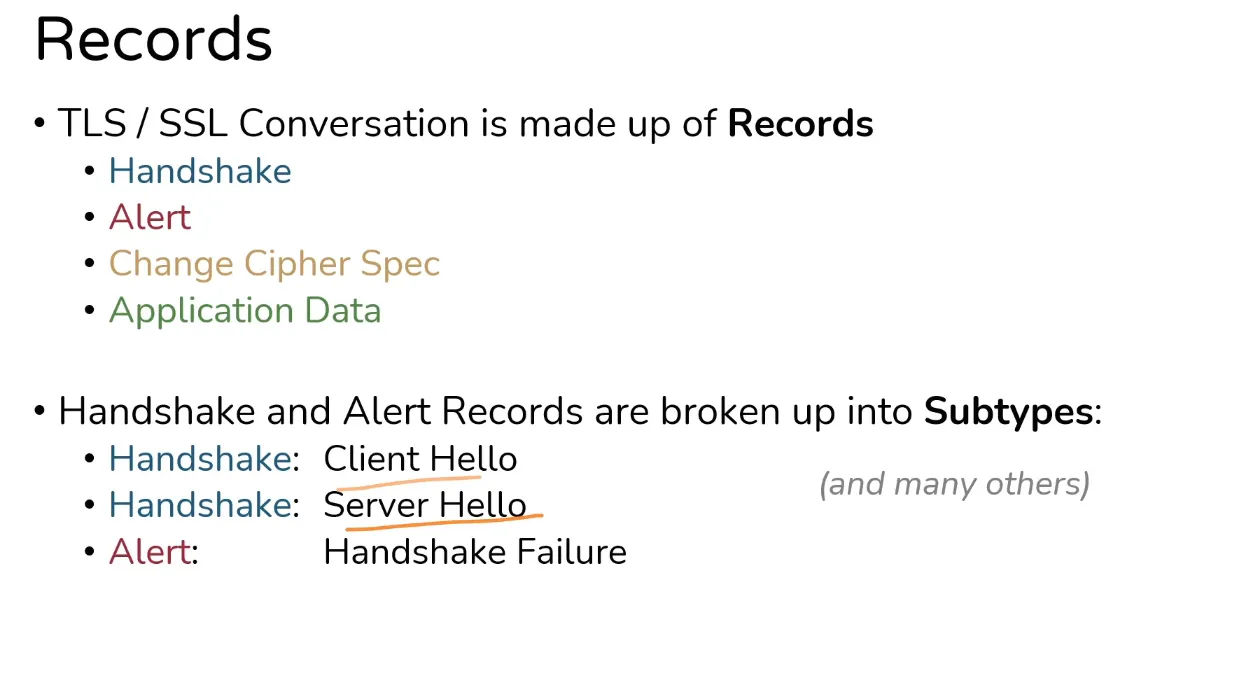
- Multiple Records can be sent at a time with different parameters
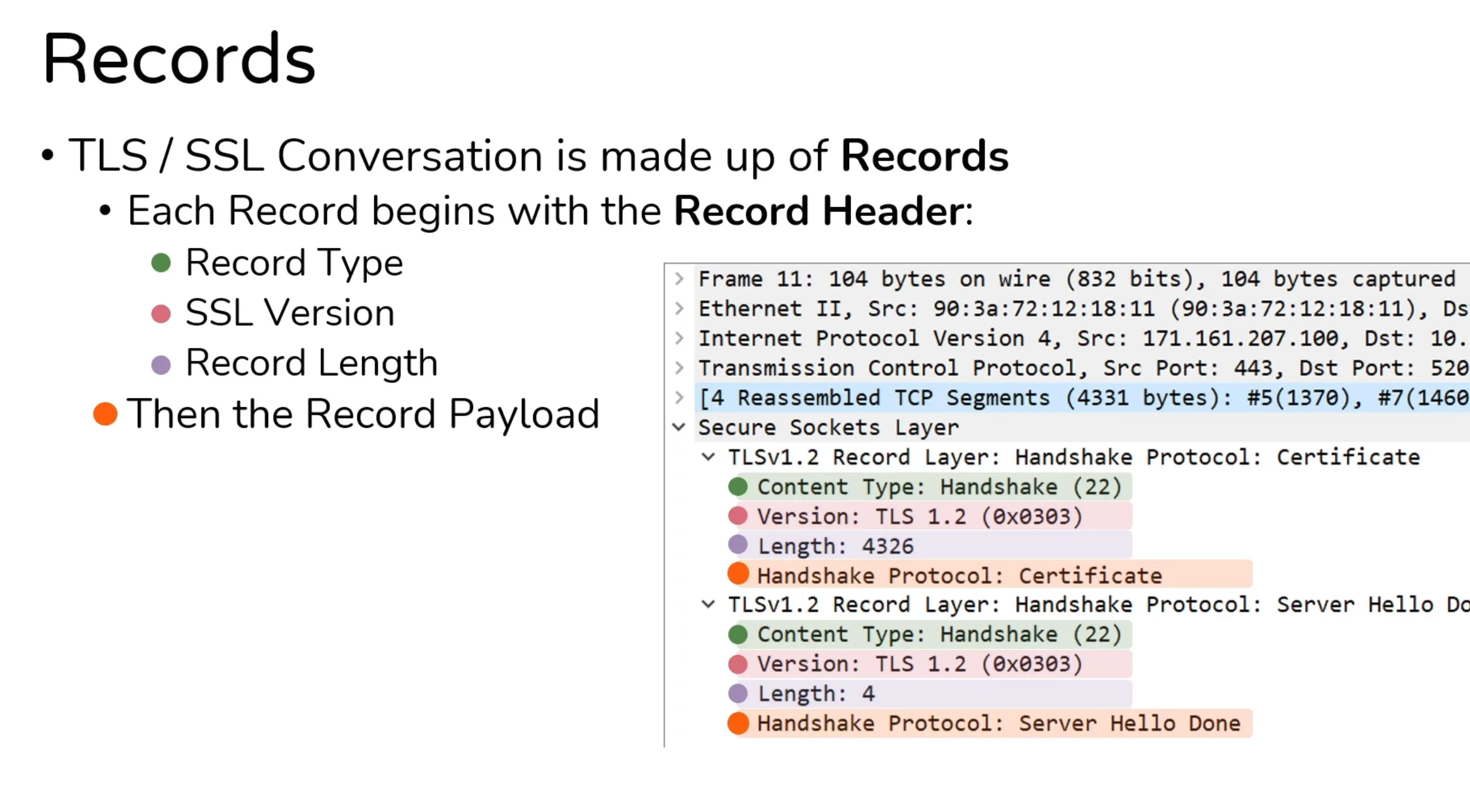
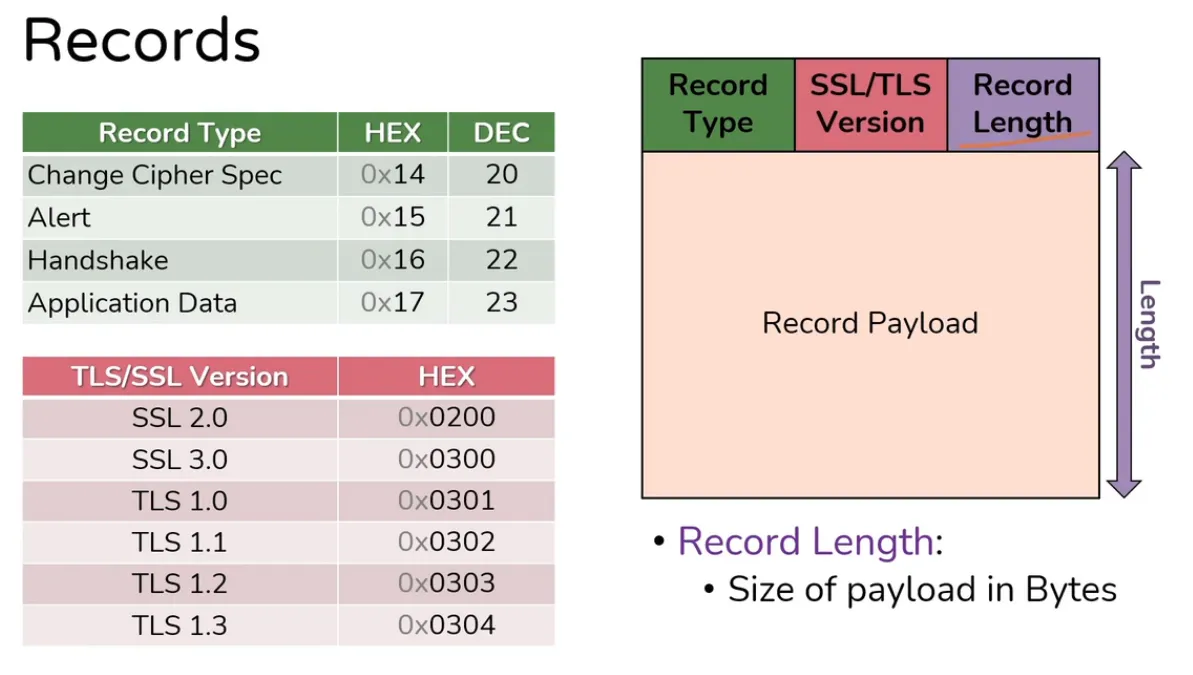
Record Header
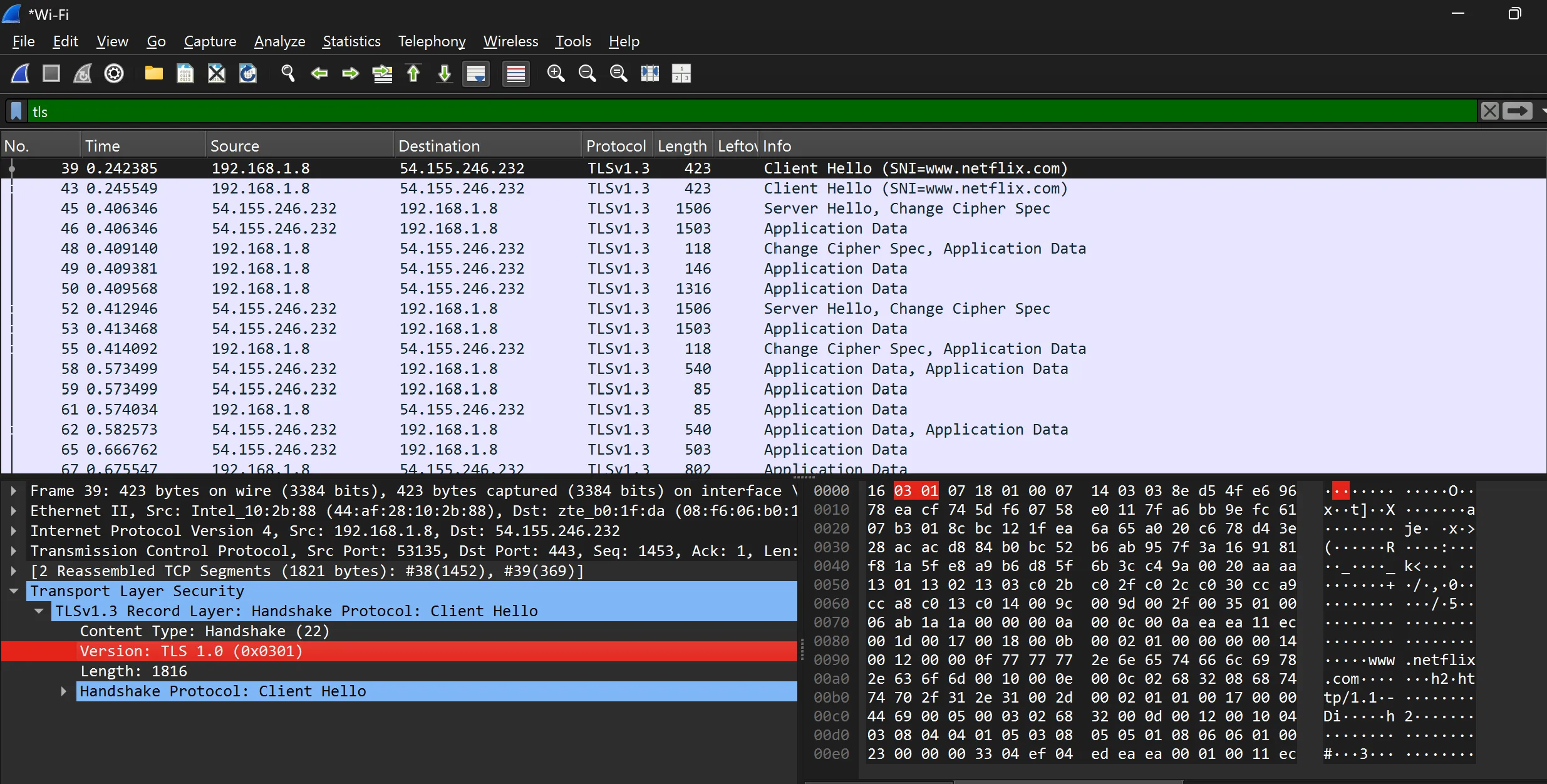
Change Cipher Specs
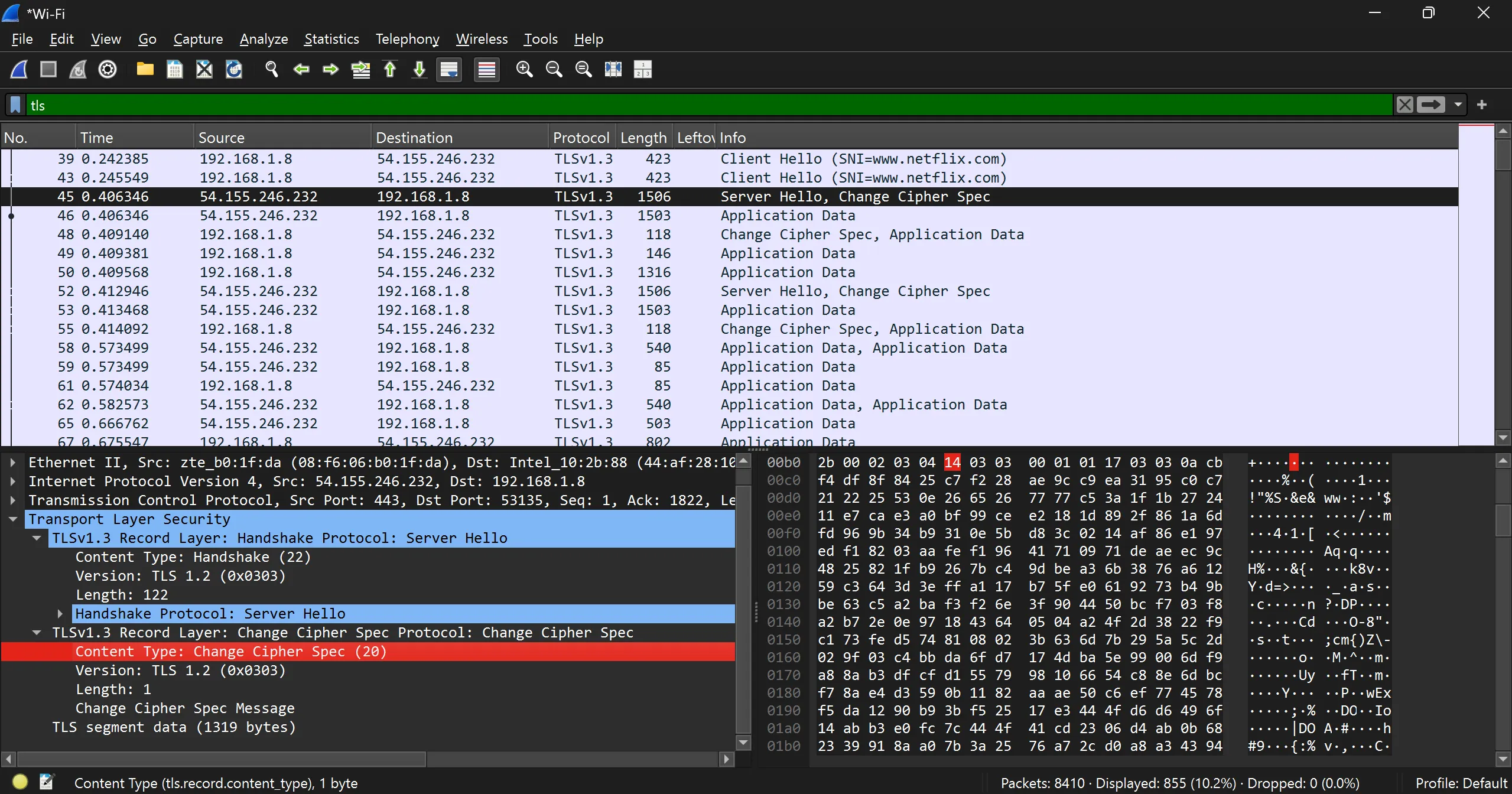
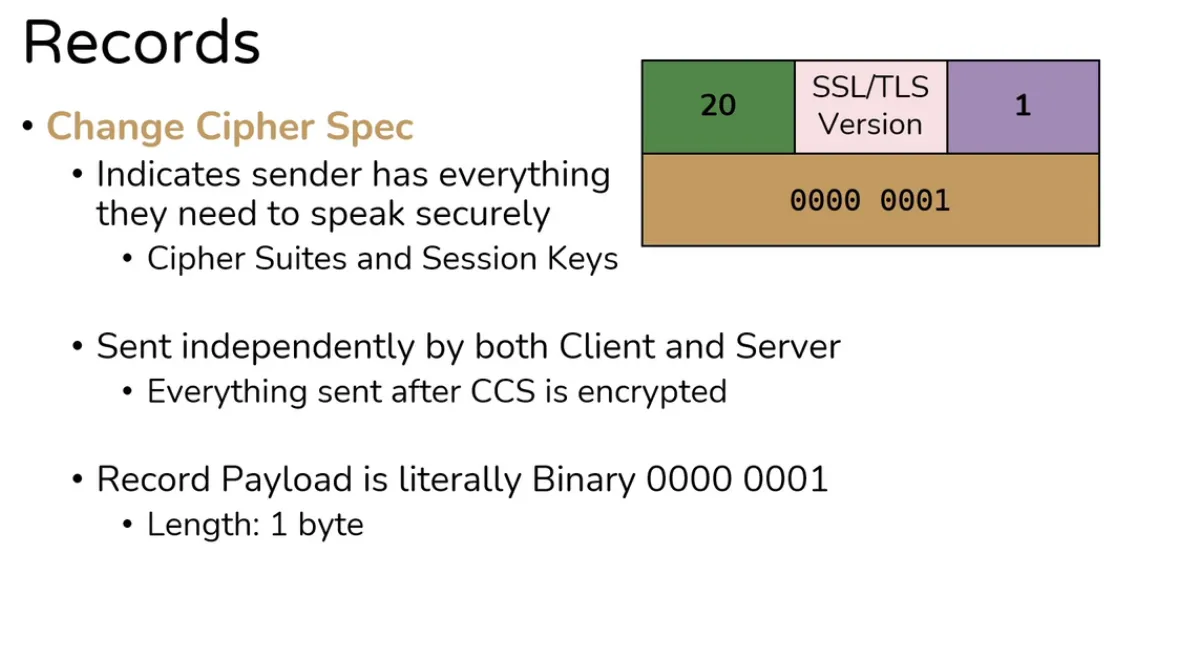
Alert Record
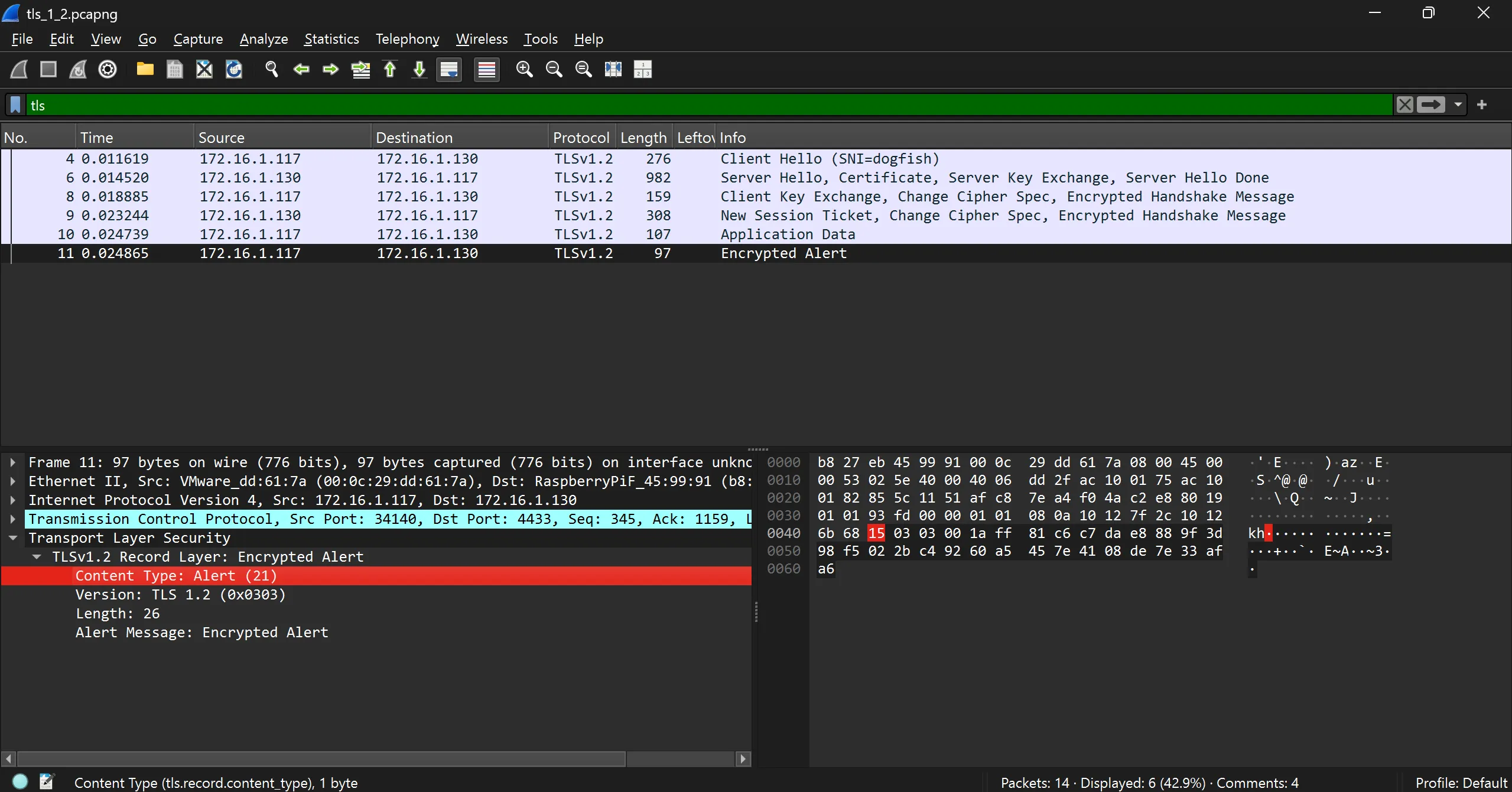
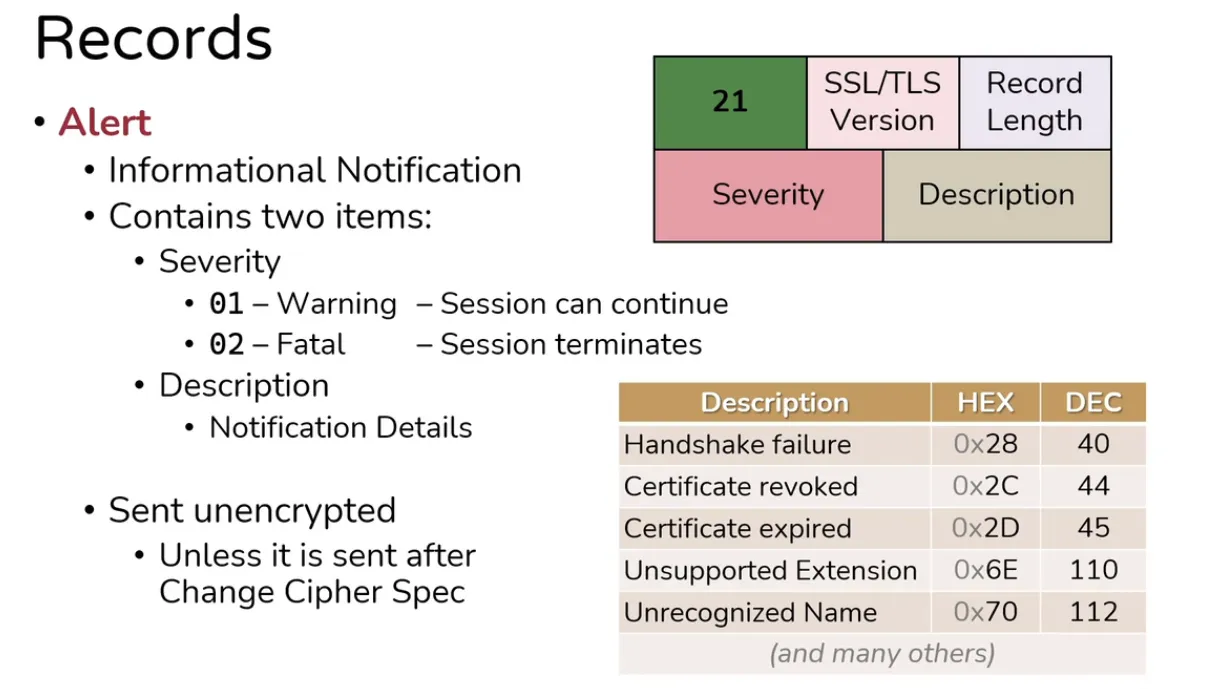
Handshake Records
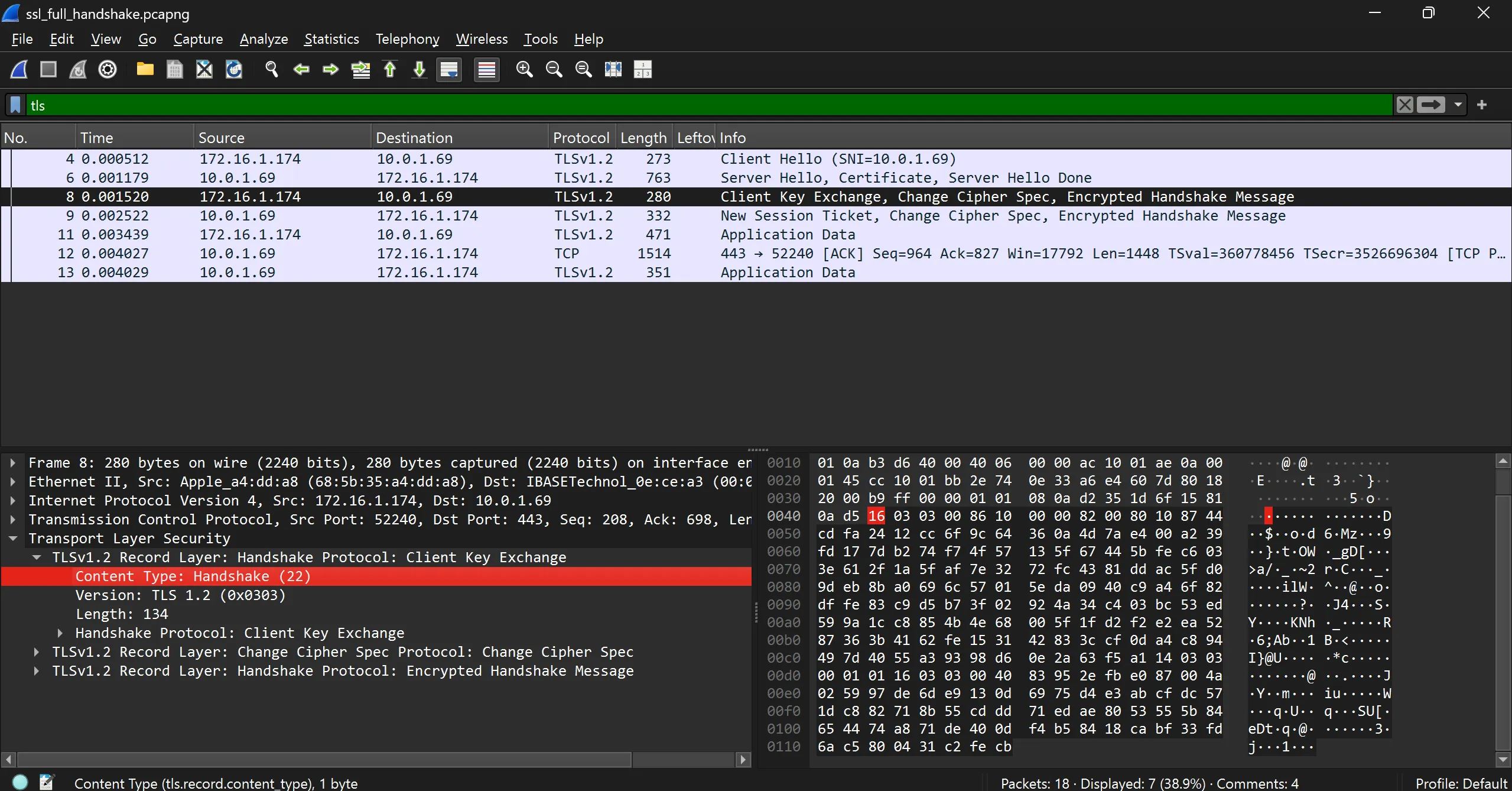
- There are certain fields which sends encrypted.
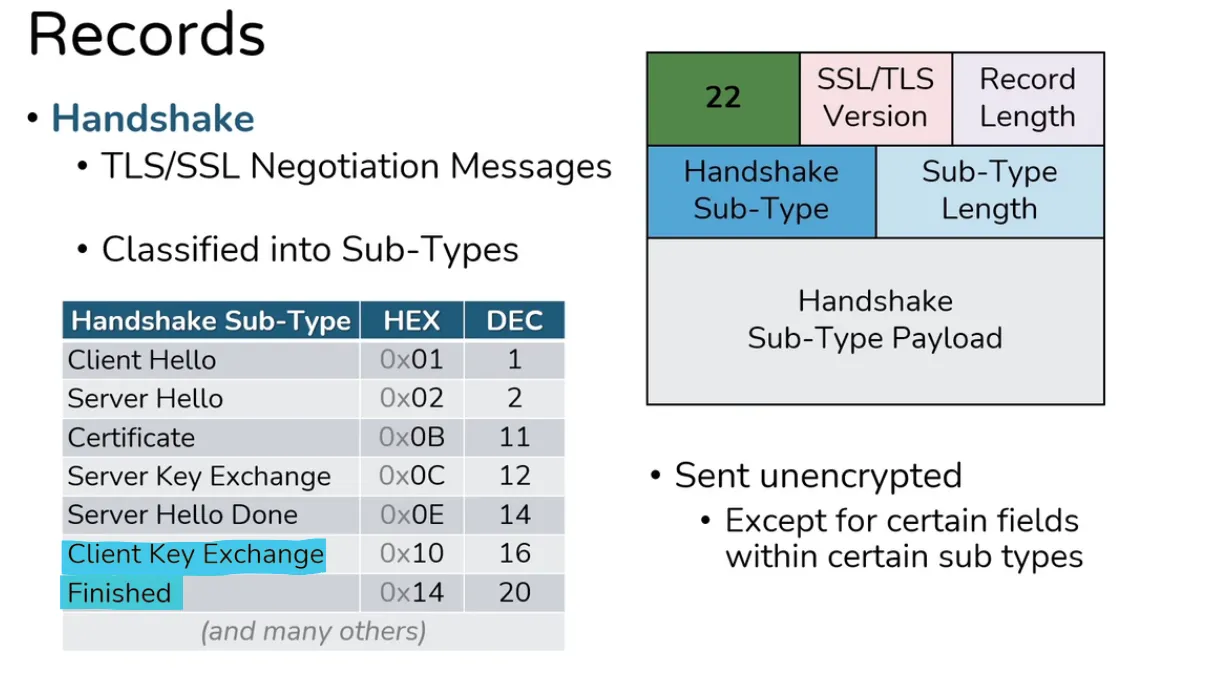
- Client Hello
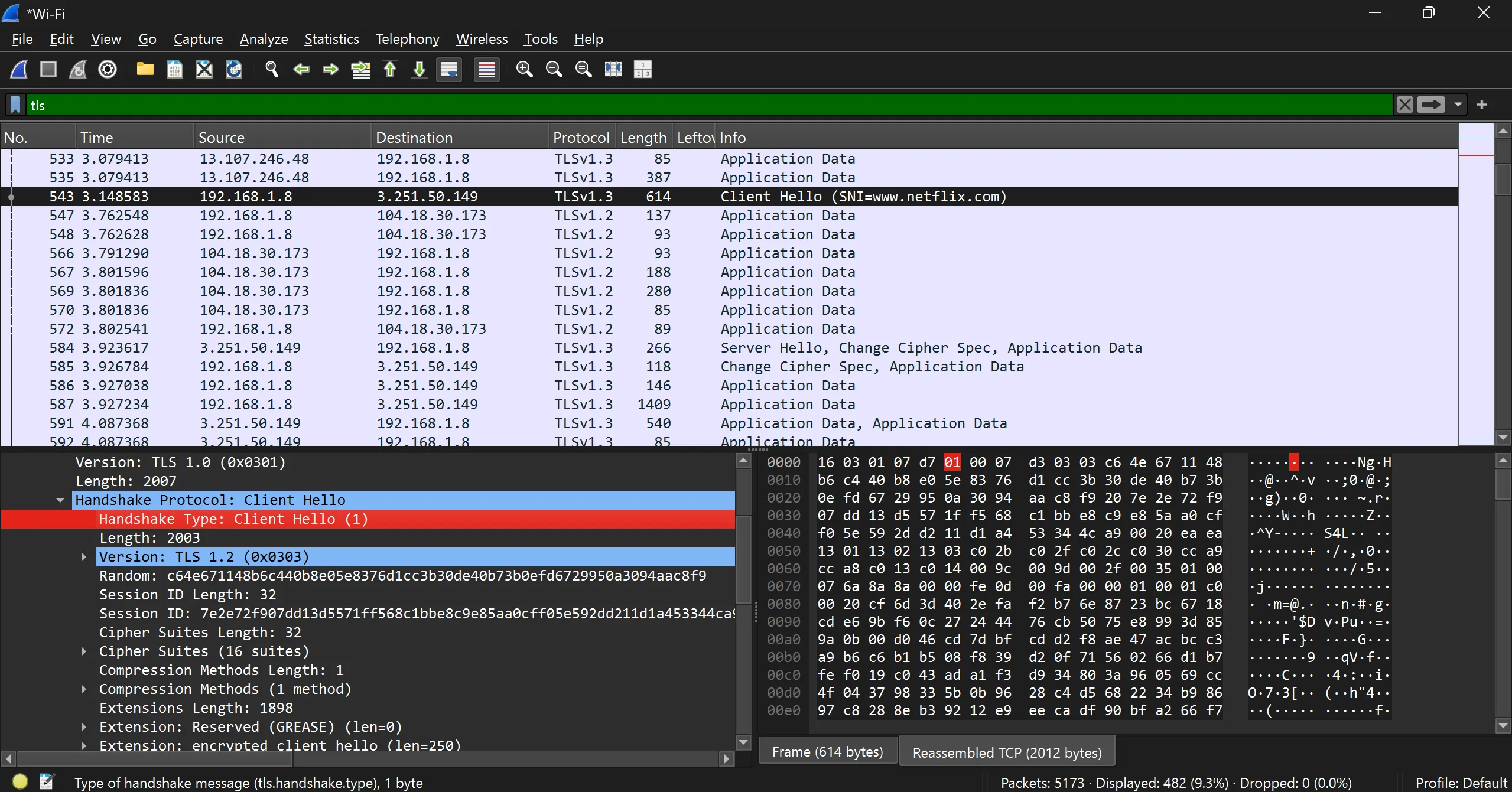
- Server hello
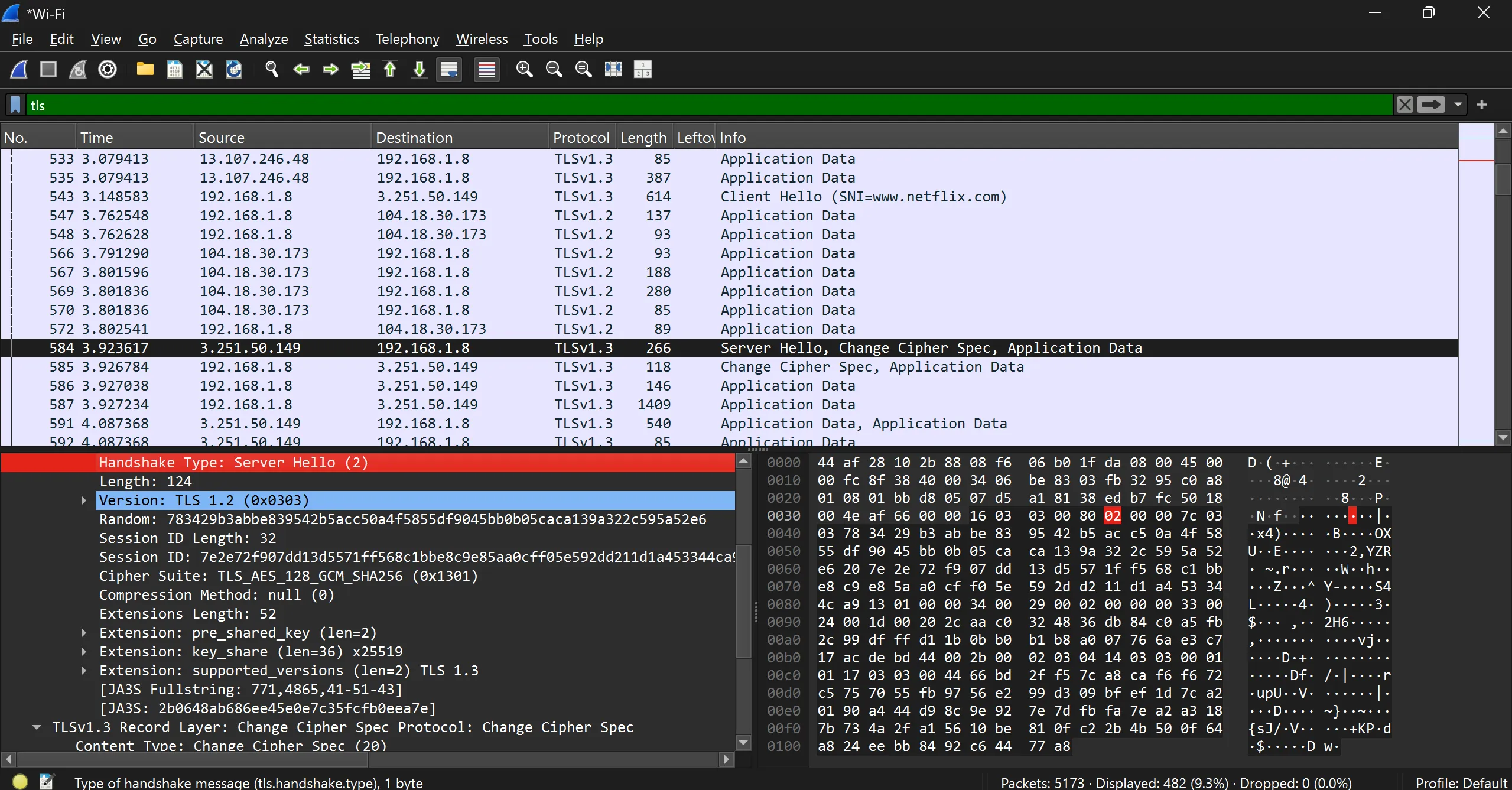
- Certificate
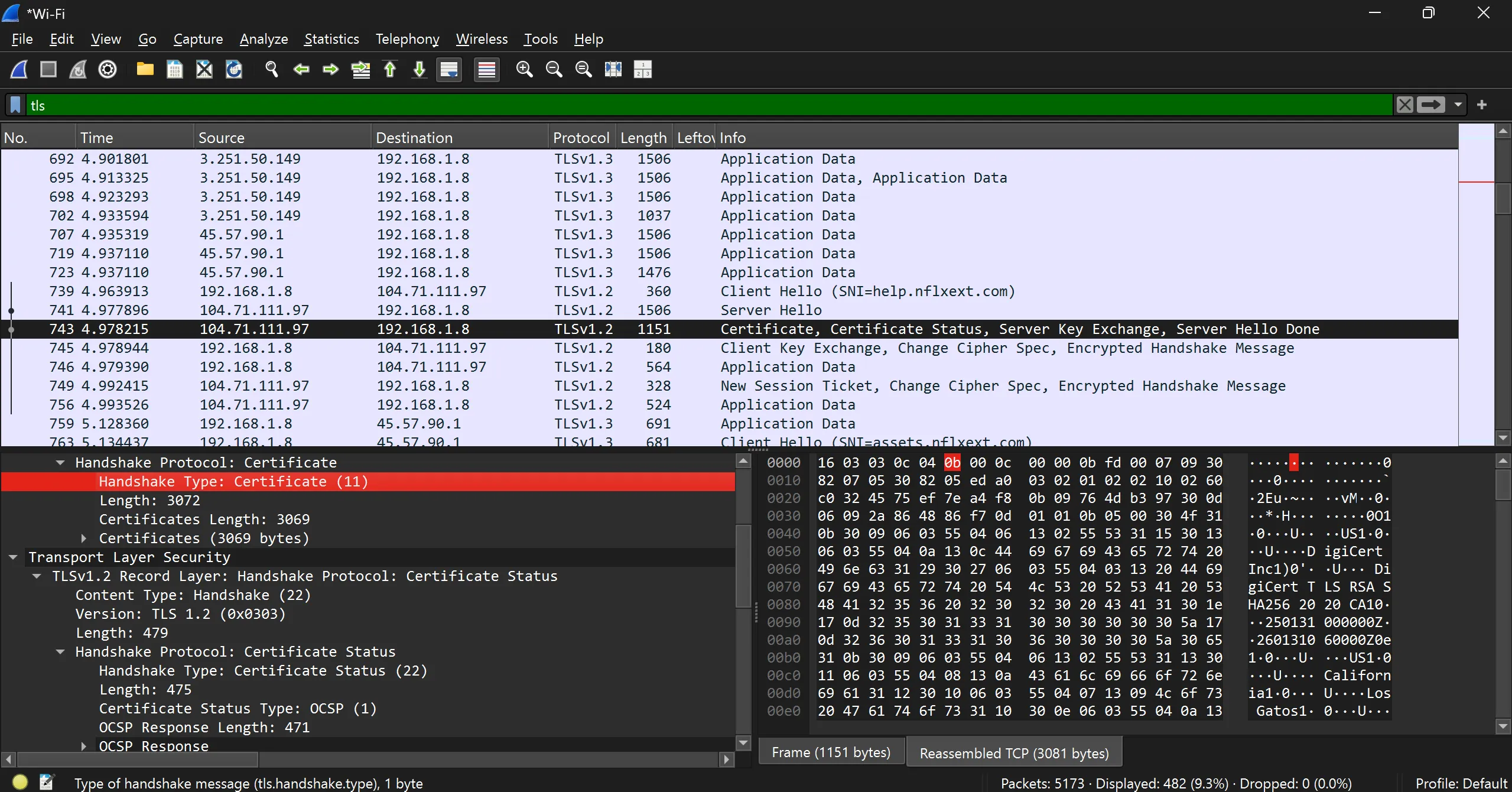
- Server Key Exchange
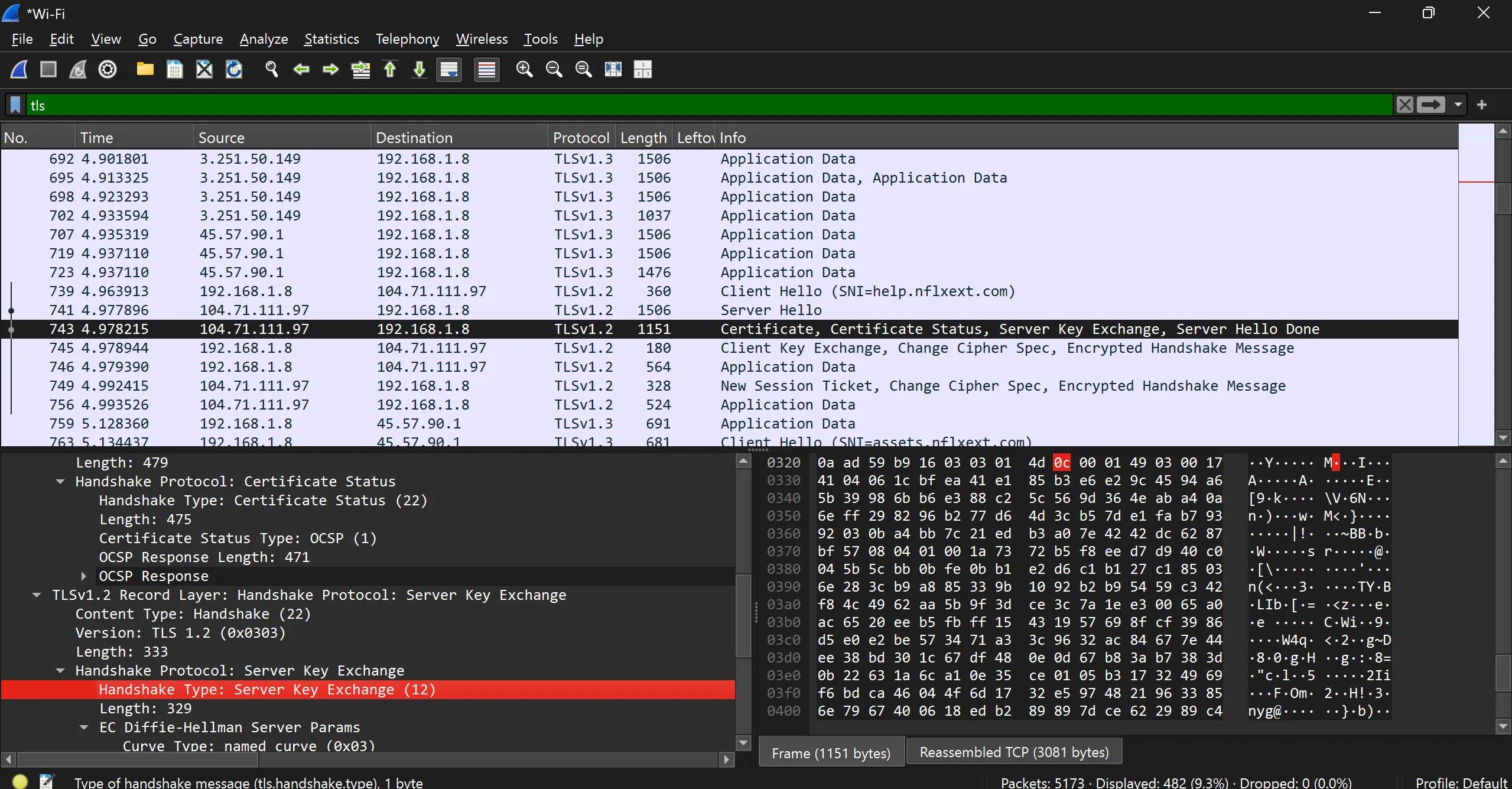
- Server Hello Done
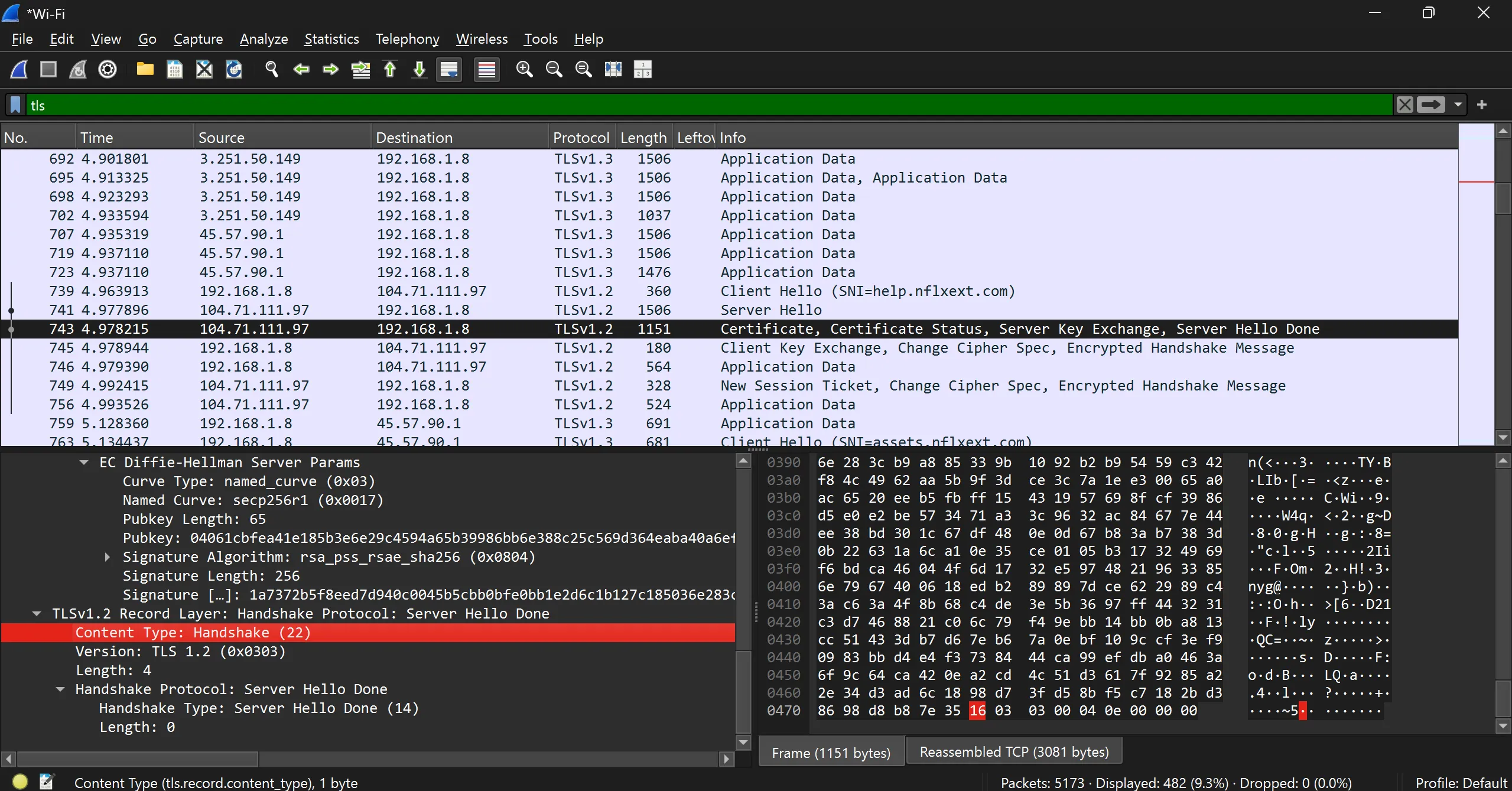
- Client Key Exchange
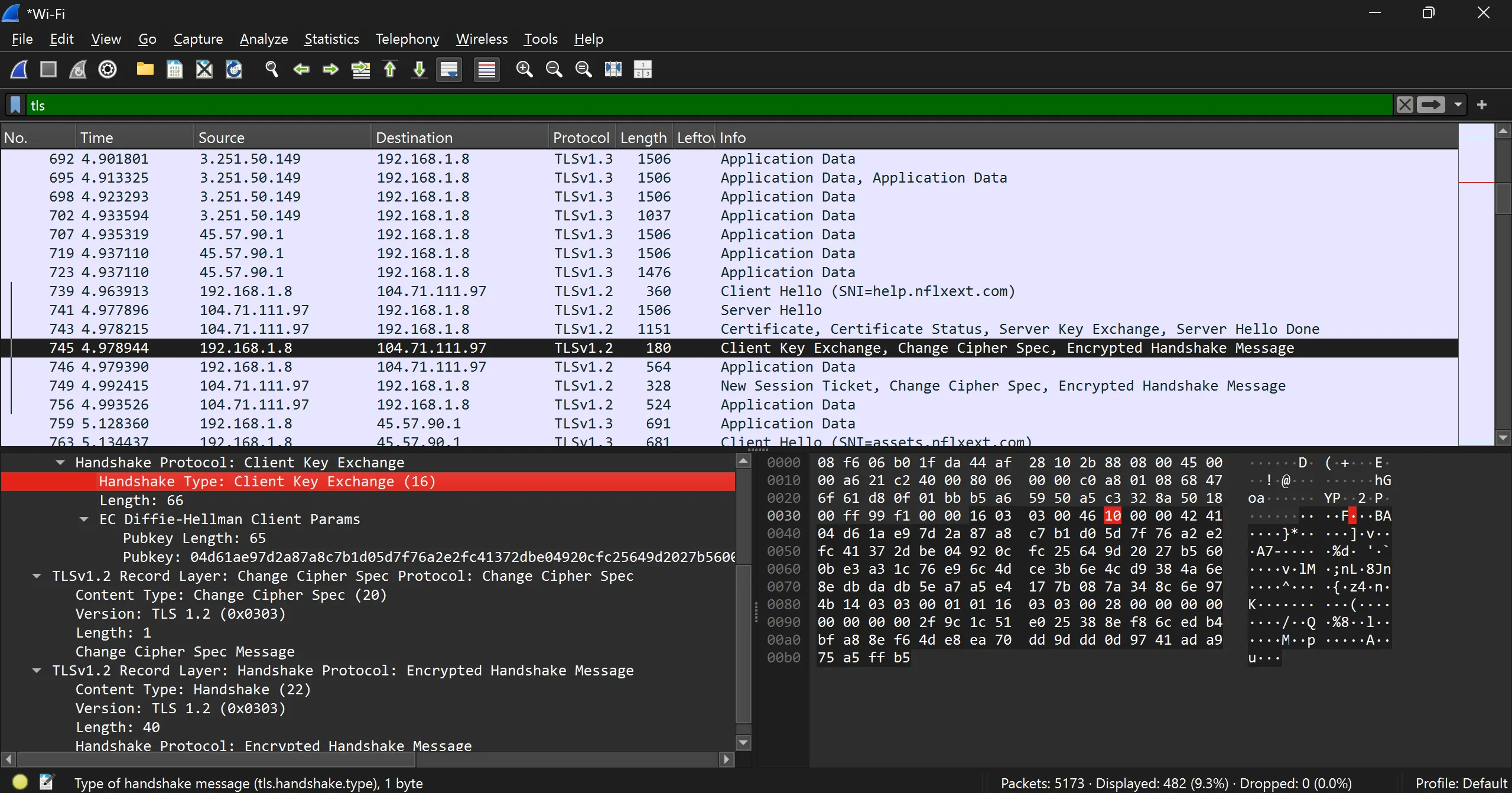
Application Data
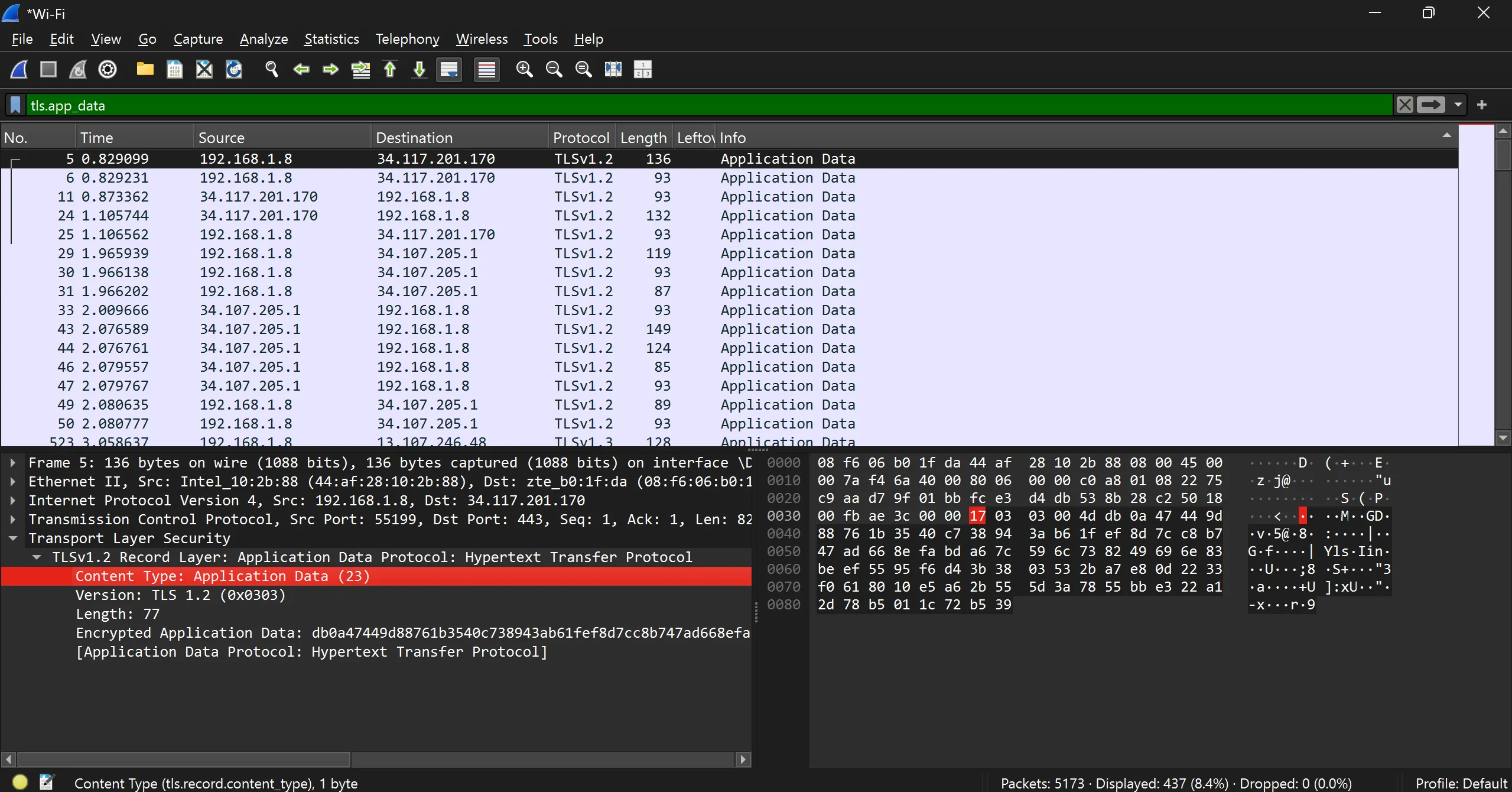
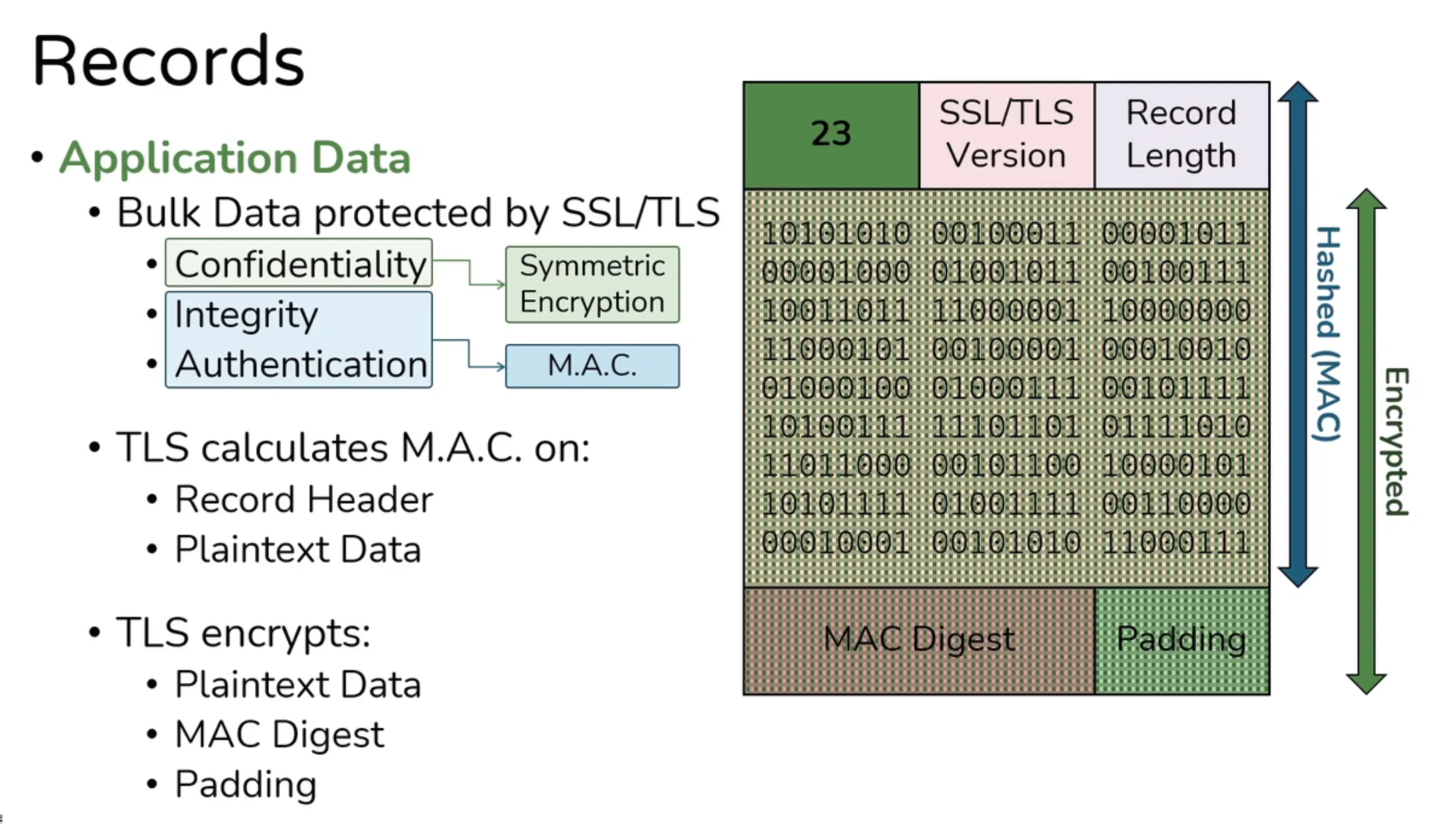
- This MAC-then-Encrypt is vulnerable to Padding Oracle On Downgraded Legacy Encryption (Poodle) attack because padding is seprated.

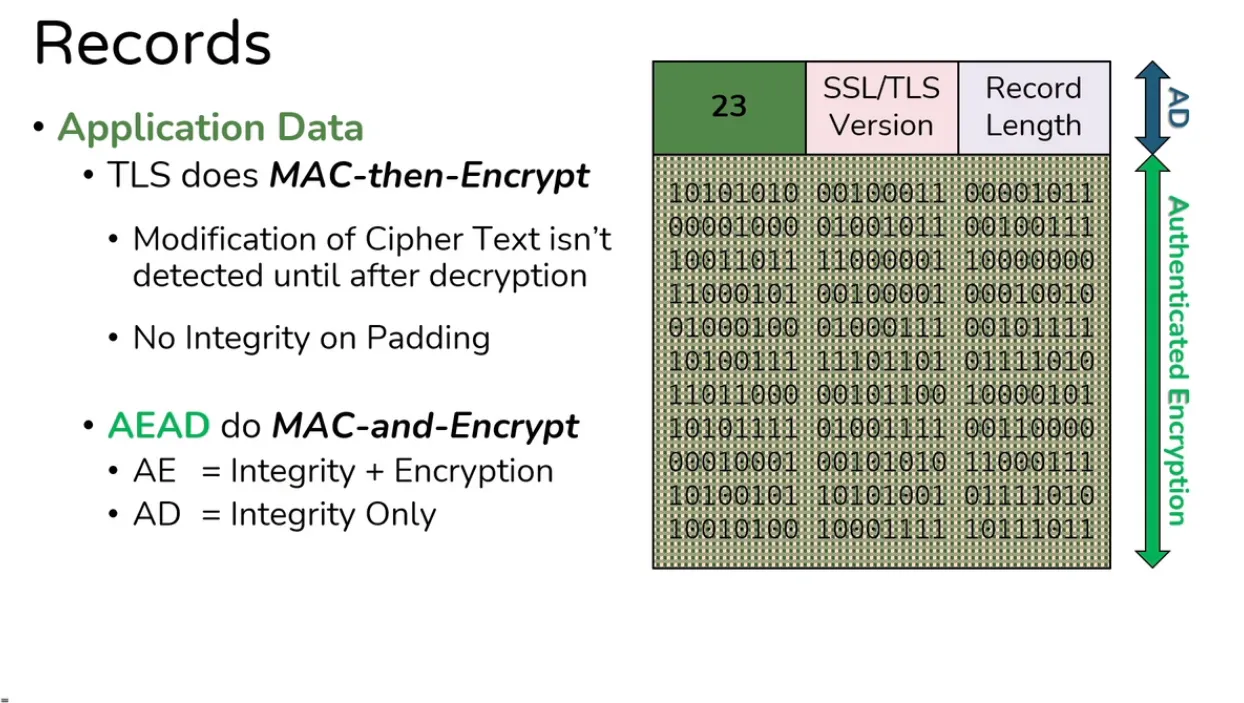
Actual Handshake
- Working Flow of TLS Handshake
![[TLS Handshake Excalidraw]]
Client Hello
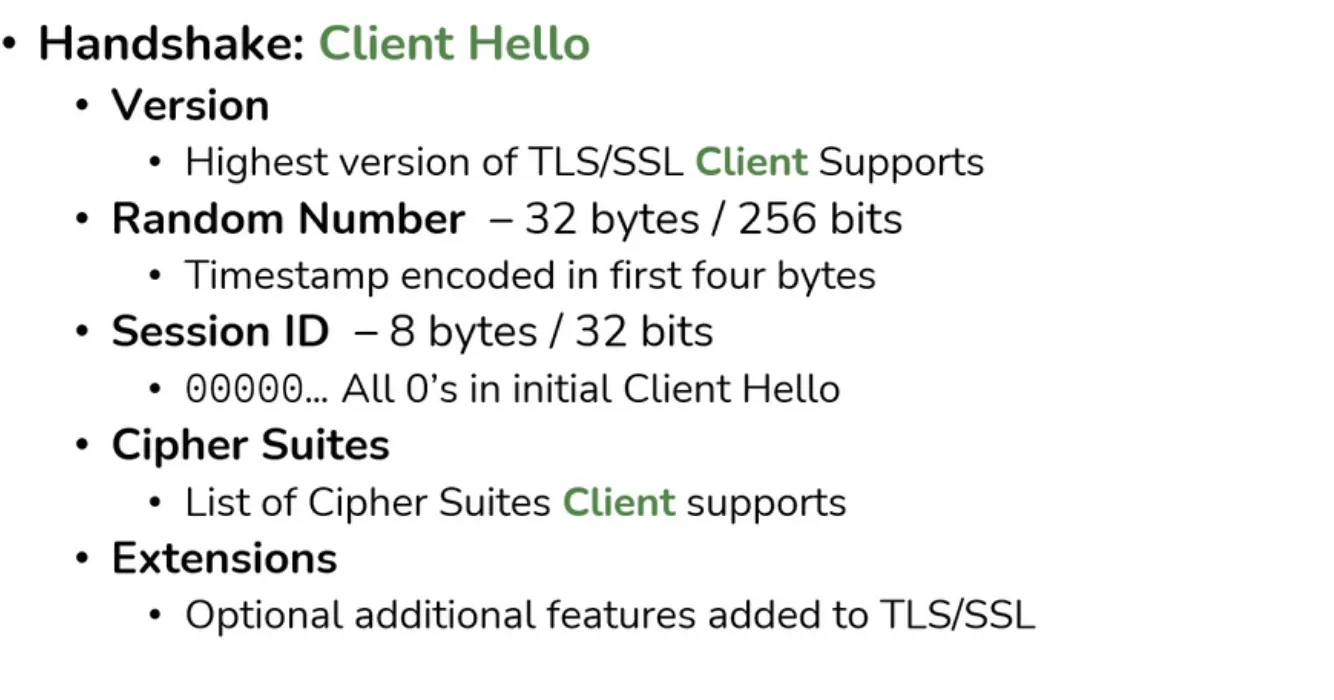
Server Hello
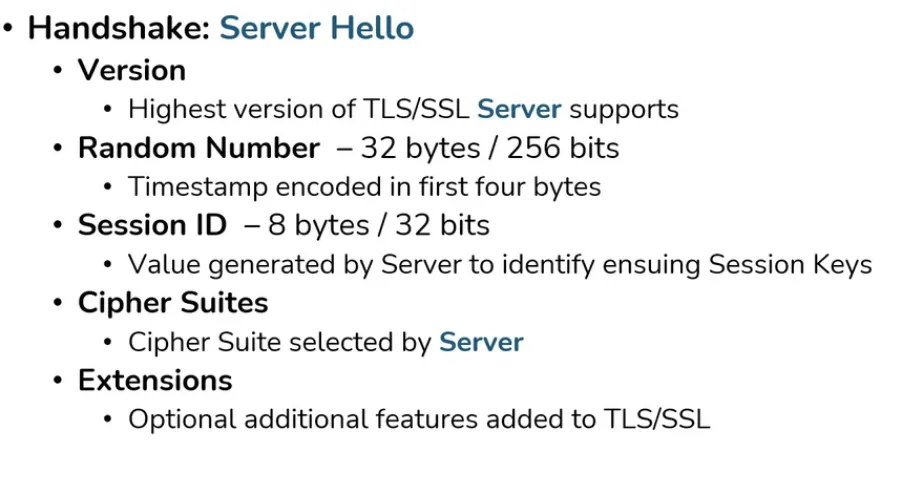
Certificate

Server Hello Done

Client Key Exchange
- Client Generates a PreMasterSecret
- Used for generate session keys
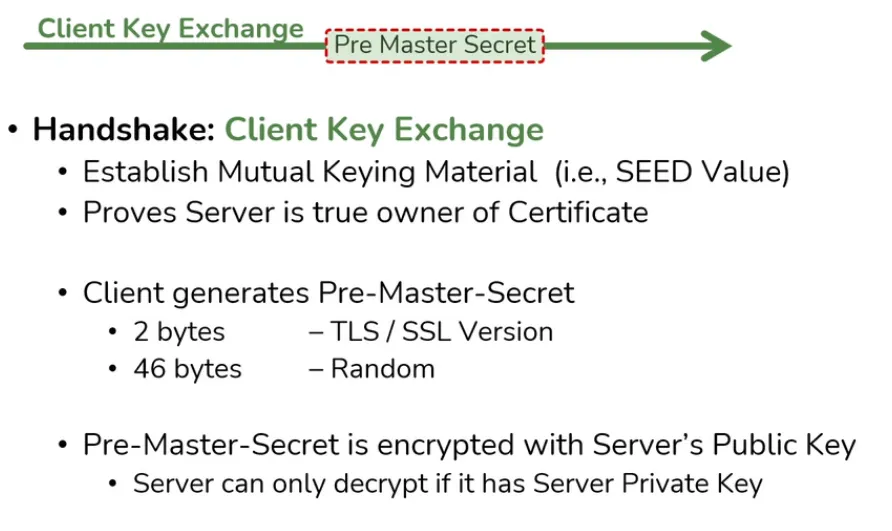
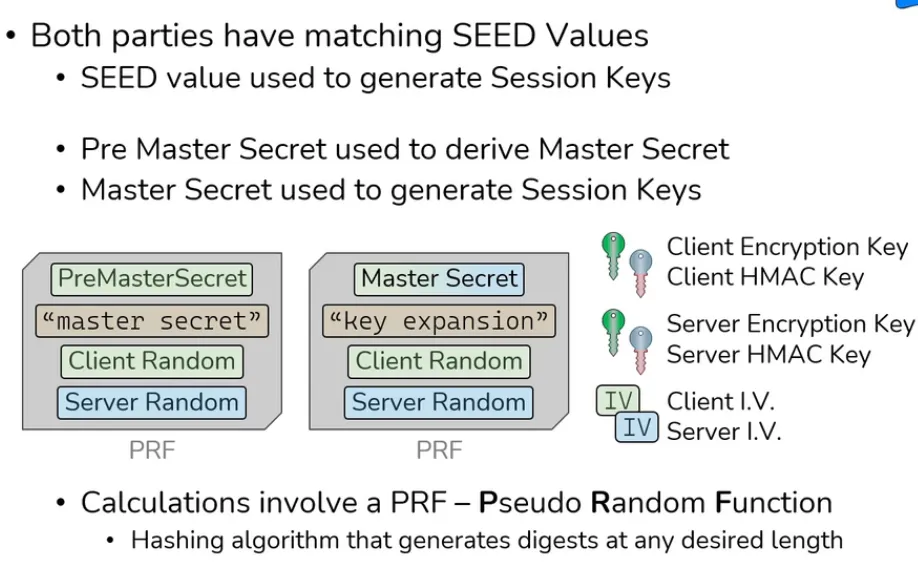
Why 4 Symmetric Session Keys??
Abstract >
> Client and Server creates two different tunnel for data transfer one for client to server` and another for server to client.
> If Attacker by chance successful to bruteforce one pair or keys then they only able to compromise half of conversations.
Hint >
> In this demonstration we have used RSA but there are other algorithms like ECDHE and DHE which has some different mechanisms.
Change Cipher Spec from Client to Server
- Indicates that client has everything necessary to speak securely

Finished from Client to Server
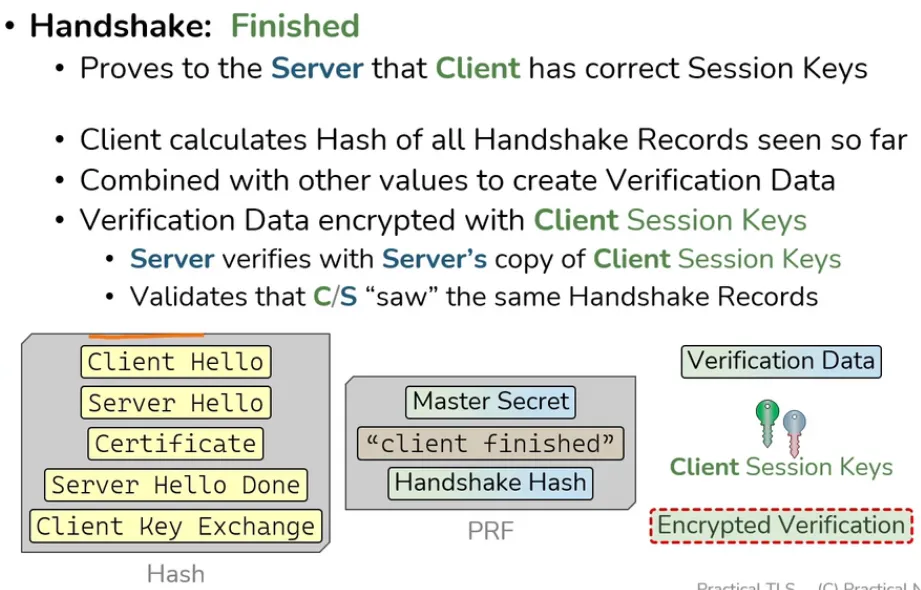
Change Cipher Spec from Server to Client
- Indicates that server has everything necessary to speak securely

Finished from Server to Client
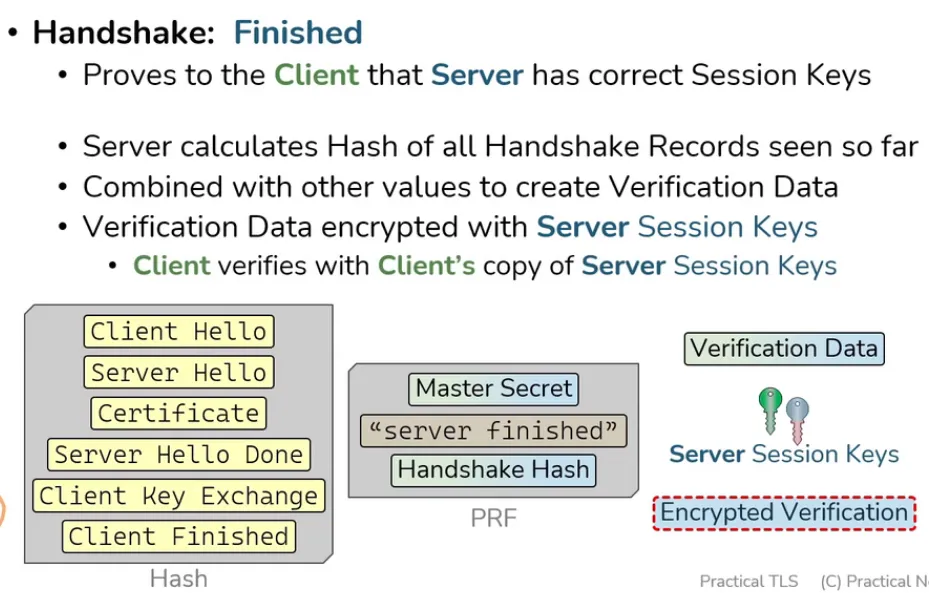
Application Data
